Welcome to a new year of ROOM•MATE! This year 100 artworks from the Tang Museum collection will be offered for loan to Skidmore students. With this project, we open up the traditional museum walls to the living spaces of our students. We believe this special access to the collection and the opportunity to experience art in everyday settings can be fundamental in developing lasting relationships to art and ideas.
We offer our sincere thanks to those who helped create our student art loan program and for the generous support that made it possible. The idea for a loan program at Skidmore started in 2018 with a group of students who researched how other academic institutions run their loan programs and how one could work at the Tang. That research led to the inaugural year of loans in 2019. Over the past seven years the loan collection has grown to 100 works, and includes a spring lottery for artwork returned from students studying abroad.
This fall students will select artworks at our annual ROOM•MATE Selection Day to bring home for the year. This day has become a beloved Skidmore tradition. We continue to collect stories in journals that go home with each artwork and share those student reflections with the larger community. You are invited to check back on our website for updates, pictures, and the inspirational growing archive of past ROOM•MATE seasons.
Ian Berry Dayton Director

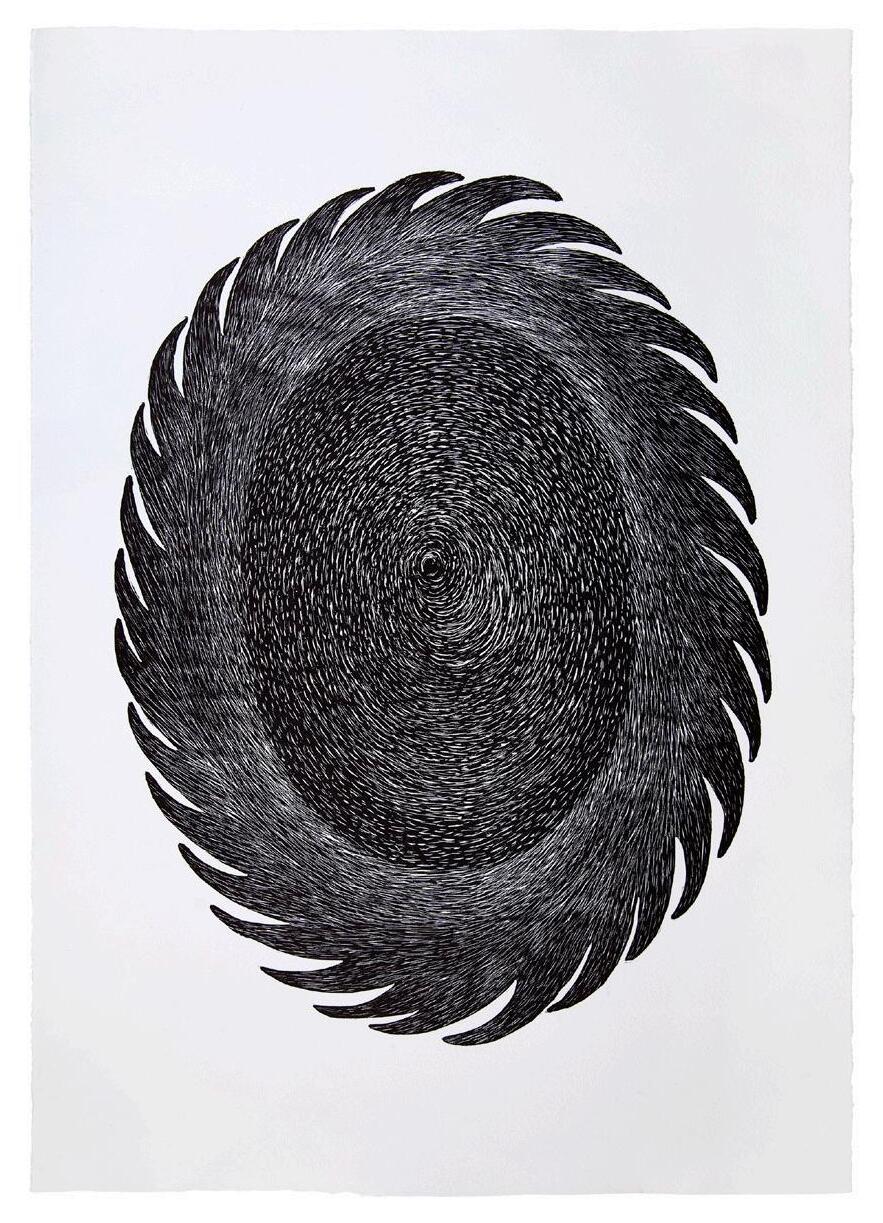
Ruth Asawa
(born Norwalk, California, 1926; died San Francisco, 2013)
Petunias, 1984
Lithograph on wove paper, 15 × 15 1/4 inches (framed)
Gift of Hilary Mastropaul, 2024.10.4
Ruth Asawa was inspired by organic and biomorphic forms, creating an extensive body of looped-wire sculptures and works on paper. She experimented with a range of mediums throughout her career including drawing, sculpture, and prints, and spent two months in 1965 at the Tamarind Lithography Workshop in Los Angeles learning printmaking. While she largely focused on sculpture and public commissions, lithography was a part of her art practice throughout her career.
Sharon Bates
(born Utica, New York, 1955)
Slice, 2019
Woodblock print, 23 1⁄8 × 16 1/2 i n c h e s ( framed)
Gift of Sharon Bates, 2019.37
Sharon Bates makes eye-popping, inventive sculptures out of everyday objects, and her black-and-white ink drawings, similar to this print, turn lines and patterns into suggestive forms. Bates created Slice, the first print she’s made, during her time as a visiting artist in the Skidmore Summer Studio Art Program while working with the course “Translations and Conversations: Printing with Artists.”
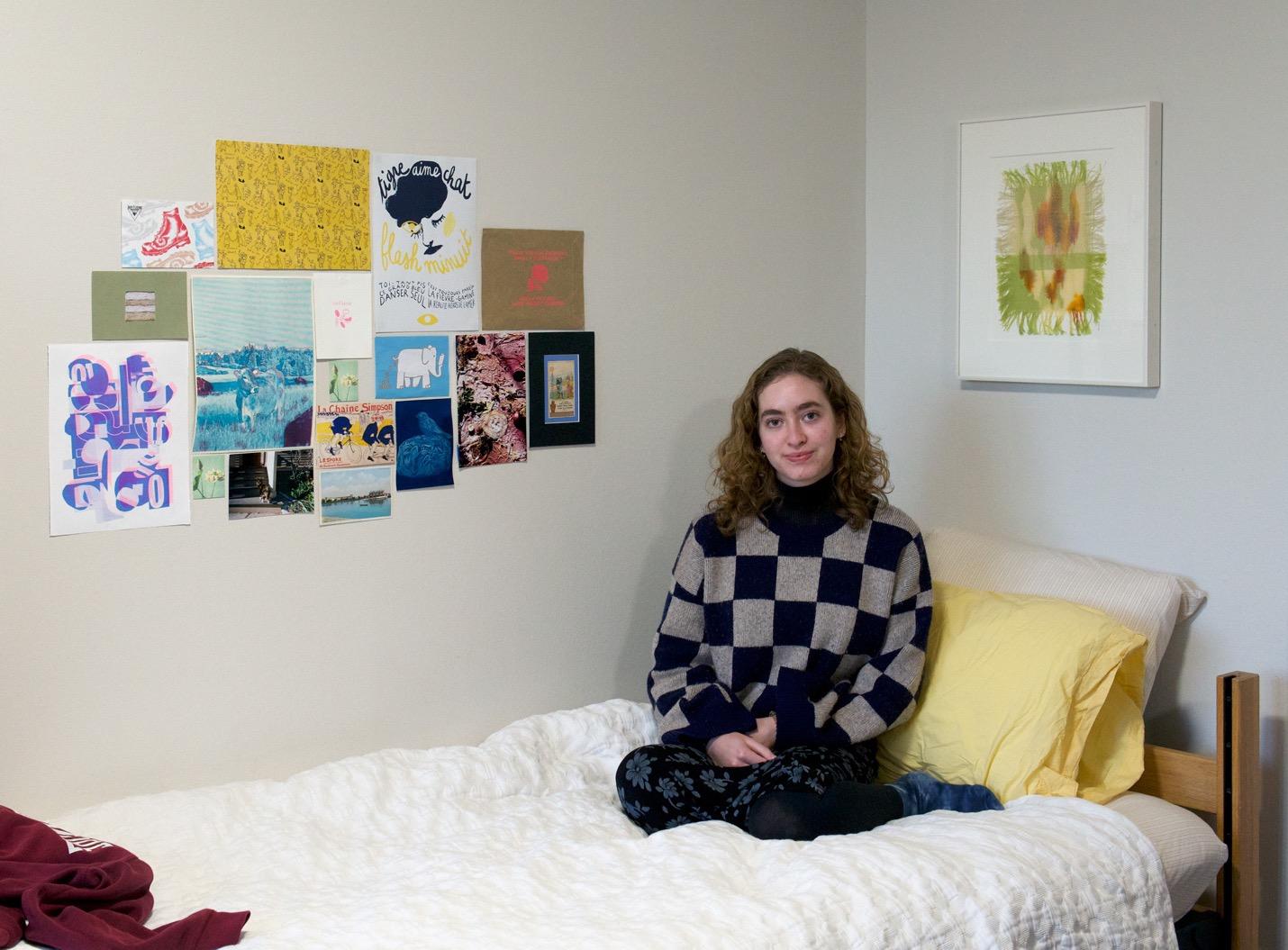
Renée Fritschel ’25
I chose Untitled #82 by Victoria Manganiello to hang above my bed. I had started weaving a few months before and fell in love with her work; I was so excited to have the opportunity to see it in my room every day. The metallic thread woven into it shines beautifully in the light.
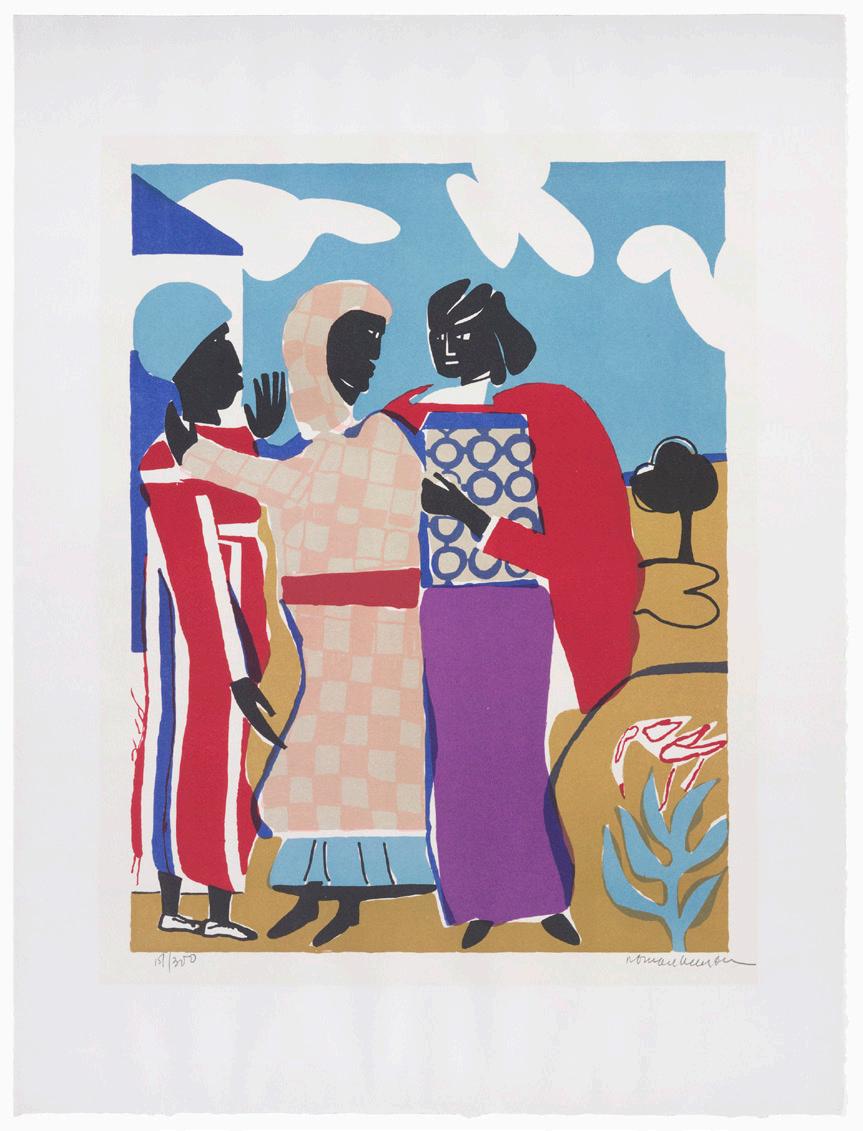
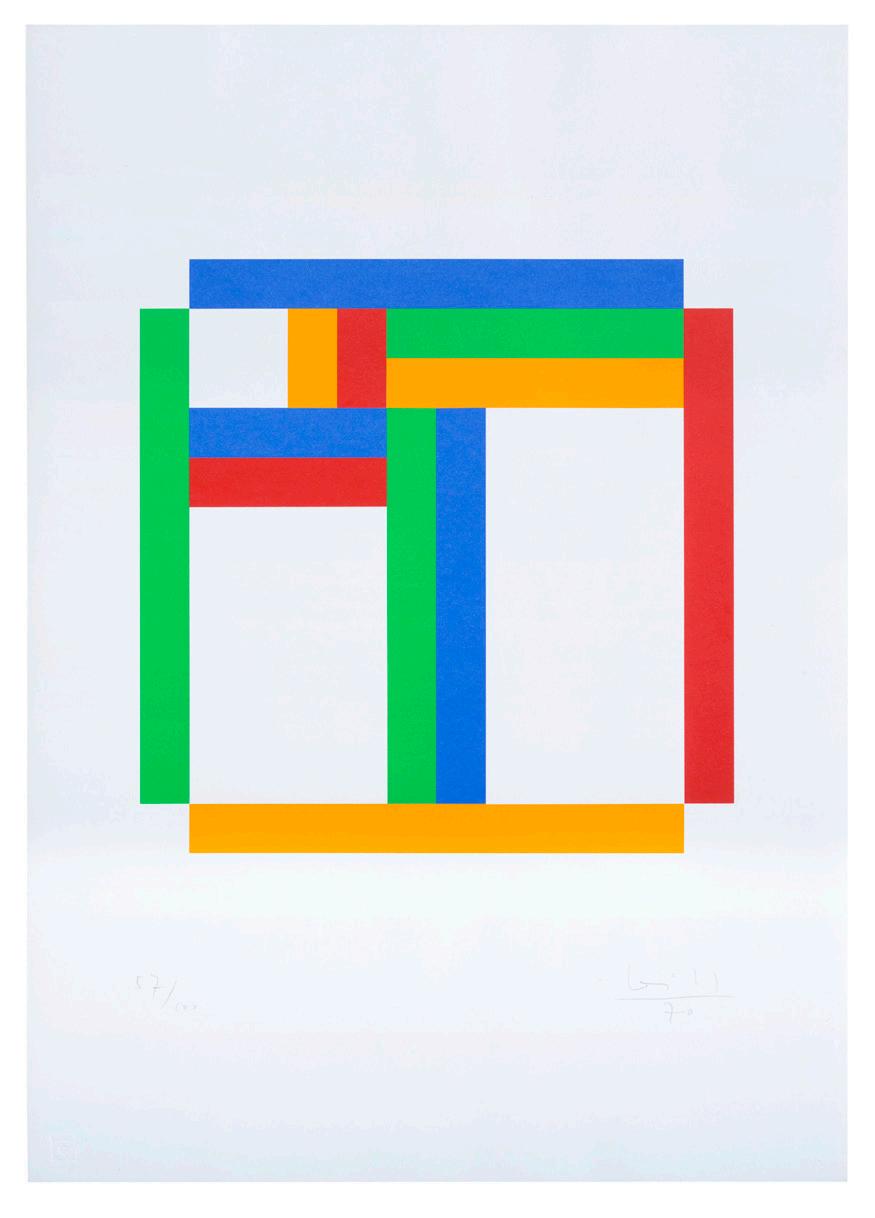
Romare Howard Bearden
(born Charlotte, North Carolina, 1911; died New York, New York, 1988)
Three Women (Easter Sunday), 1979
Screen print, 32 5⁄8 × 26 7⁄8 inches (framed)
Gift of Richard Liroff, 1985.61
“It is not my aim to paint about the Negro in America in terms of propaganda . . . [but] the life of my people as I know it, passionately and dispassionately as Breughel. My intention is to reveal through pictorial complexities the life I know.”
—Romare Howard Bearden, The Human Condition
Romare Howard Bearden grew up during the Harlem Renaissance and was immersed in jazz and blues culture. Bearden became active in the Civil Rights movement and by doing so, created a platform for African American artists that did not previously exist. Three Women first existed as a collage, from which the artist created this print.
Max Bill
(born Winterthur, Switzerland, 1908; died Berlin, 1994)
Geometrical Construction 1, 1970
Color lithograph, 28 5⁄8 × 24 3⁄8 inches (framed)
Gift of the Roberts, Cugno and Logan, Media Gallery, 2016.15.40
Max Bill was a Swiss architect, artist, painter, designer, and industrial designer who co-founded the Ulm School of Design, which followed the Bauhaus philosophy that all the arts should be combined. From this idea, Bill helped create the Concrete art movement in which geometric abstraction and the importance of line, color, and a flat plane were emphasized.
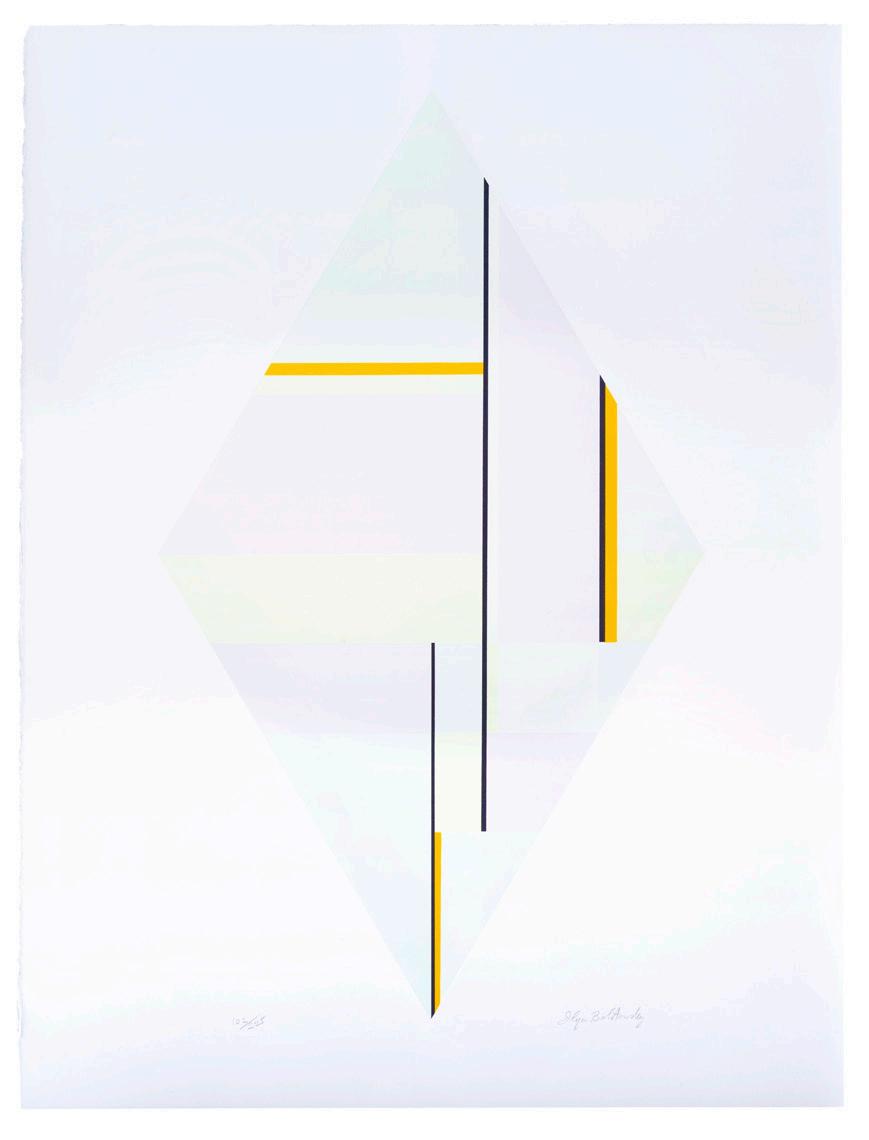

Ilya Bolotowsky (born St. Petersburg, Russia, 1907; died New York, New York, 1981)
White Diamond, 1979
Screen print, 35 1⁄2 × 23 3⁄4 inches (framed) Gift of T.O. Mathues, 1982.92
Ilya Bolotowsky lived through World War I and the Russian Revolution, fleeing to the United States as a teenager. His early experiences led to his search for “an ideal harmony and order…a free order, not militaristic, not symmetrical, not goose-stepping, not academic.” Influenced by Piet Mondrian, Bolotowsky used thin black lines, geometric shapes, and a limited color palette to achieve a sense of balance.
Jonathan Borofsky (born Boston, 1942)
I dreamed I found a red ruby, 1978-1982
Lithograph, 19 3⁄4 × 19 3⁄4 inches (framed) Gift of Jack Shear, 2020.1.3
The red ruby depicted in this print came to the artist in a dream where it was as large as his heart. Jonathan Borofsky says that his dream of the ruby was the most positive and uplifting dream he has ever had. The ruby reappears in his dreams as a symbol to help him balance out more frightening dreams.
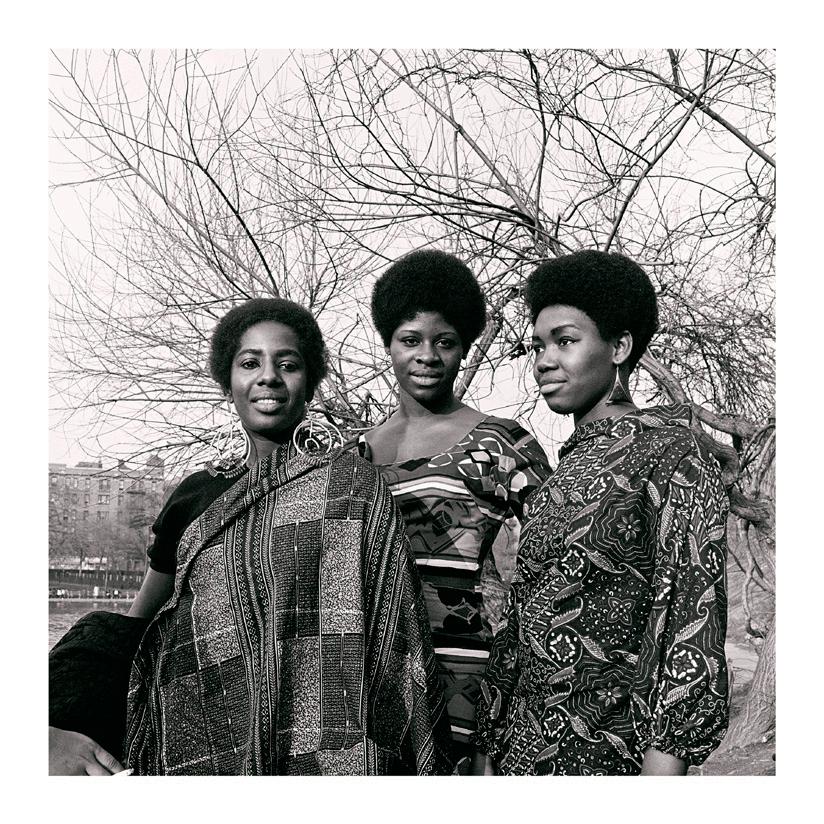
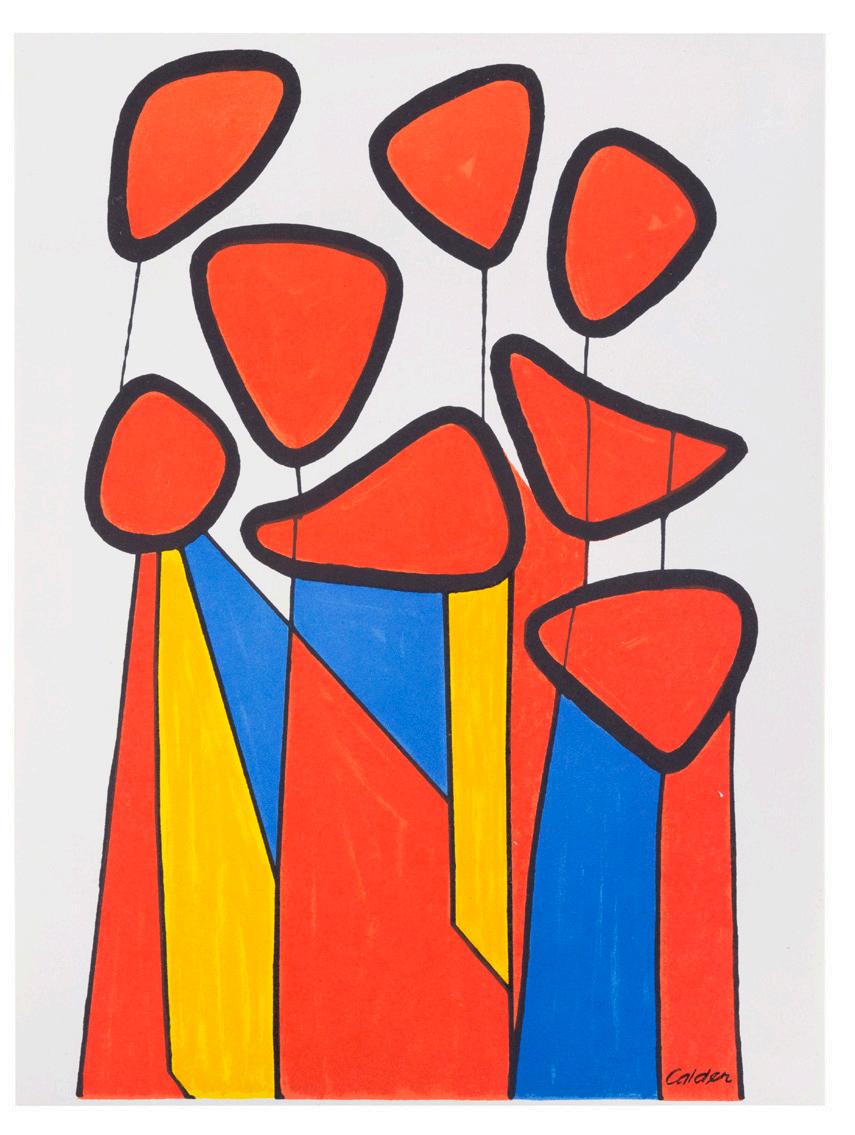
Kwame Brathwaite
(born New York, New York, 1938; died New York, New York, 2023)
Untitled (Mt. Morris Park photoshoot with Black Rose, Sikolo Brathwaite and Nomsa Brath), 1967, printed 2018
Archival pigment print, 21 ¾ × 21 ¾ inches (framed) Tang purchase, 2018.24.2
Kwame Brathwaite was a photographer who helped create the Black Is Beautiful movement of the 1960s and 1970s. In support of this movement, Brathwaite took studio portraits of a specific group of Black models whom he called the Grandassa models. They sported bright, bold printed outfits and natural hairstyles. Brathwaite’s contribution to this movement celebrated the natural beauty of Black people in opposition to the Eurocentric beauty standards that were widespread at that time.
Alexander Calder
(born Lawnton, Pennsylvania, 1898; died New York, New York, 1976)
Spring Carnival, published 1978
Lithograph, 18 3⁄4 × 15 1⁄4 inches (framed) Gift of Richard Levine, 2003.1.3.3
From a young age, Alexander Calder was encouraged by his parents to make art. Inspired by his love for the circus, he was influenced by artists such as Miró, Mondrian, and Duchamp—who would later help coin the term for his kinetic sculptures known as mobiles. Calder worked in various mediums including sculpture, painting, and printmaking.
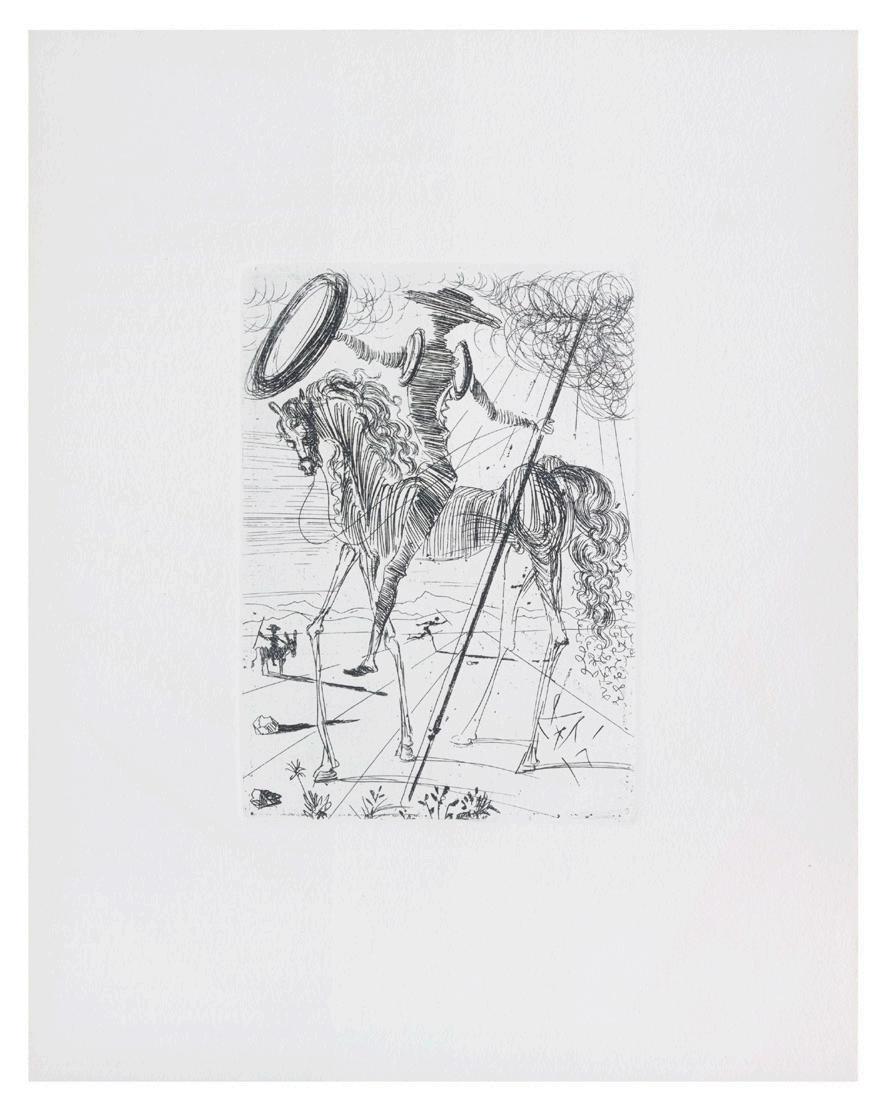

Salvador Dalí
(born Figueres, Spain, 1904; died Figueres, Spain, 1989)
Don Quixote (Don Quichotte) 1966, published 1978
Etching, 15 × 12 1⁄2 inches (framed)
Gift of Richard Levine, 2003.1.3.7
This etching by Salvador Dalí is based on Don Quixote, the character in the eponymous novel written by Miguel de Cervantes. Don Quixote is a Spanish nobleman who reads so many chivalrous romances he loses his mind—all while riding his horse through Spain. The novel is recognized as one of the most influential novels of the Spanish Golden Age.
Stuart Davis
(born Philadelphia, 1894; died New York, New York, 1964)
Untitled, 1964
Screen print on Mohawk Superfine paper
21 5⁄8 × 24 1⁄4 inches (framed)
Gift of Anne T. Palamountain, 1966.4.6
Stuart Davis is a leading figure of American Modernism. Through the use of hard-edged, bold forms and expressive colors, his work translates everyday life into an abstracted language of shapes and symbols, expressing the spirit of popular culture.


Gracia Parkhill Dayton (born Belmont, Massachusetts, 1934; died Massachusetts, 2024)
Untitled (Landscape #7), n.d.
Watercolor on paper, 17 ¾ × 14 inches (framed)
Gift of Heather Dayton Wilson, 2022.23.8
A 1956 Skidmore alumna, Gracia Parkhill Dayton is known for her brightly colored landscapes and celebrated within the watercolor community. In this painting, red flowers blend together in the forefront of a richly hued pastoral landscape, evoking the abundance of nature.
Benjamin Degen (born Brooklyn, New York, 1976)
Mountain, 2020
Screen print, 19 1/2 × 24 ¾ inches (framed)
Gift of Ian Berry, 2020.10.3
Benjamin Degen makes paintings, drawings, and prints. Through his expressive mark making and organic patterns, he turns ordinary, natural scenery into lively compositions. Degen’s black-and-white prints retain a sense of the vibrancy of his brightly colored paintings through his energetic layering of marks and high contrast. Here, two hands form a frame over the mountainous landscape in the distance.

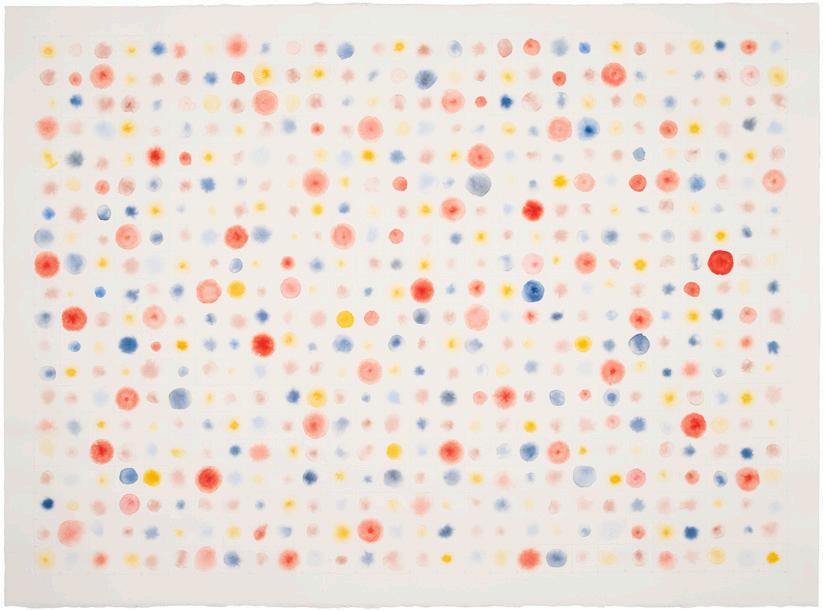
Dorothy Dehner
(born Cleveland, Ohio, 1901; died New York, New York, 1994)
Lunar Series #7, 1971
Lithograph, 10 1/2 × 27 1/4 inches (framed)
Gift of Dorothy Dehner, Class of 1952, 1975.6.7
Dorothy Dehner was heavily influenced by nature, her European travels, and modernist movements such as constructivism and cubism. She is best known for her large abstract sculptures, but early in her career she made drawings, paintings, and prints like Lunar Series #7. A 1952 Skidmore alumna, Dehner attended college after divorcing her husband, the sculptor David Smith, and leaving their farm in Bolton Landing, New York.
Mary Jane Duffy
(born Evanston, Illinois, 1966; died Chicago, 2021)
Untitled, 2008
Watercolor and pencil on paper
26 1/2 × 34 ⁵⁄8 inches (framed)
Gift of Kristen Schupp Cormier ’87, Kirsten Dieterich Pitts ’87, and Lisa Bowers Walker ’87 in memory of our friend Mary Jane Loucks Duffy ’88, 2023.6
Skidmore alumna Mary Jane Duffy’s paintings and drawings investigated the artificiality of technology and the imperfections of human creation. In Untitled, delicately drawn lines create a gridded backdrop to a field of colorful dots. The effect is reminiscent of television snow, pixels, information passing through the web, and individuals within a whole. But these are just a few of the myriad associations and evocations her work can engender.
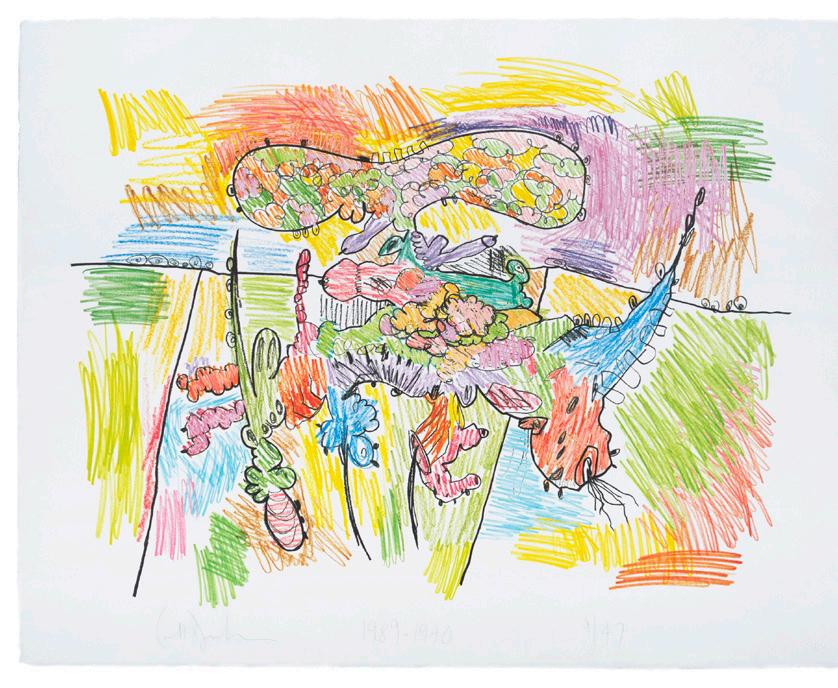
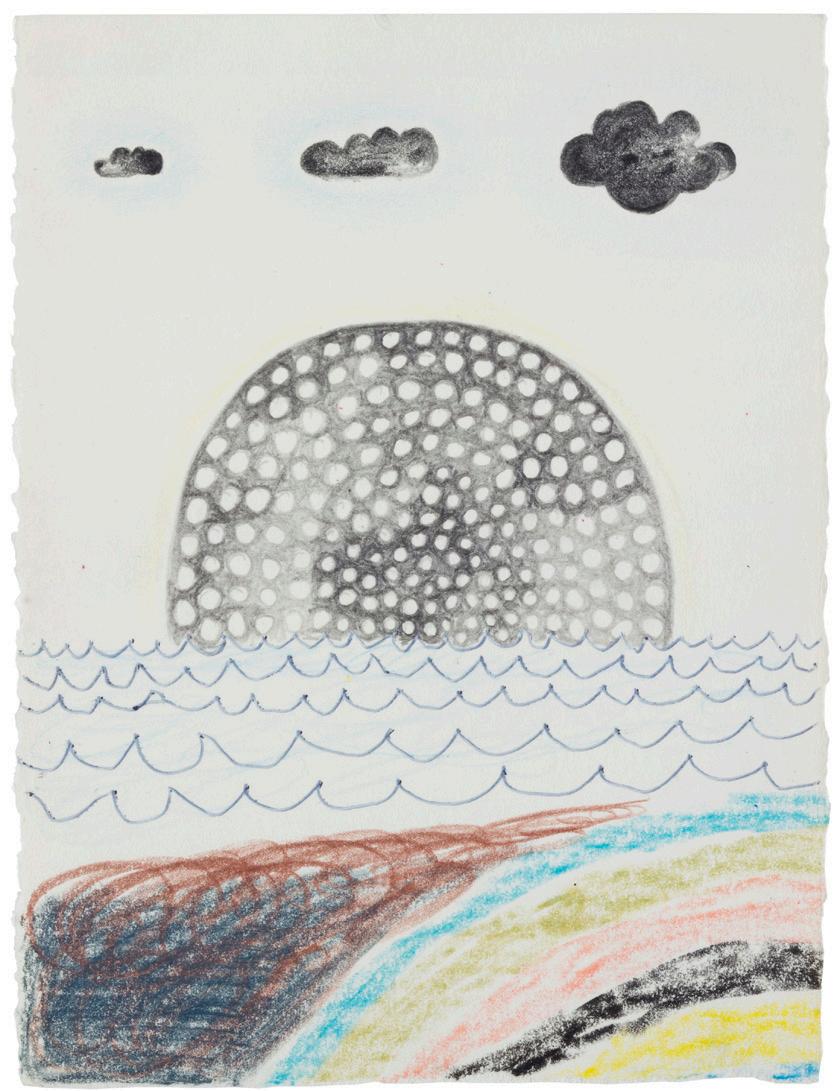
Carroll Dunham (born New Haven, Connecticut, 1949)
Floating Shape with Backdrop, 1989-1990
Lithograph on paper, 28 × 32 3⁄4 inches (framed)
Gift of Jack Shear, 2020.1.5
Carroll Dunham playfully paints the human figure with thick black outlines and energetic colors. Dunham’s work explores the nature of painting and its relationship to personal identity through a mix of abstraction and representation.
David Dupuis (born Holyoke, Massachusetts, 1959)
Visions of Pantelleria, 1995
Color pencil and graphite on paper 13 1⁄4 × 11 1⁄8 inches (framed)
Gift of Judi Roaman, 2016.19.9
Surreal landscapes and biomorphic forms are often joined in David Dupuis’s compositions. His works serve as a visual diary, a reflection of his day-to-day existence. The title of this work refers to an Italian island and commune in the Mediterranean Sea known for being a celebrity hideaway that is often referred to as Italy’s “Secret Island.”
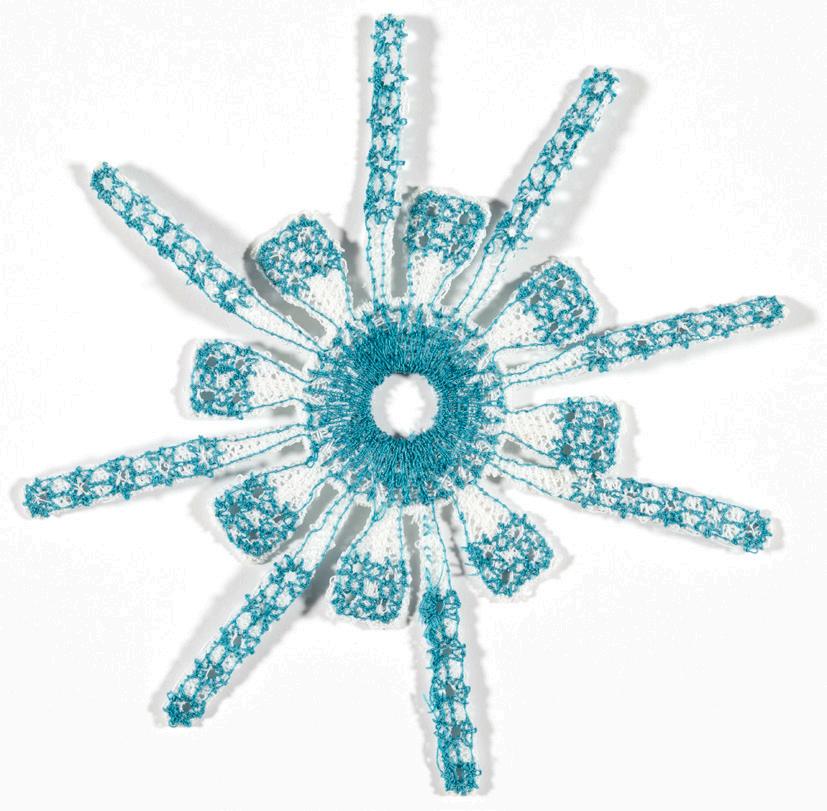
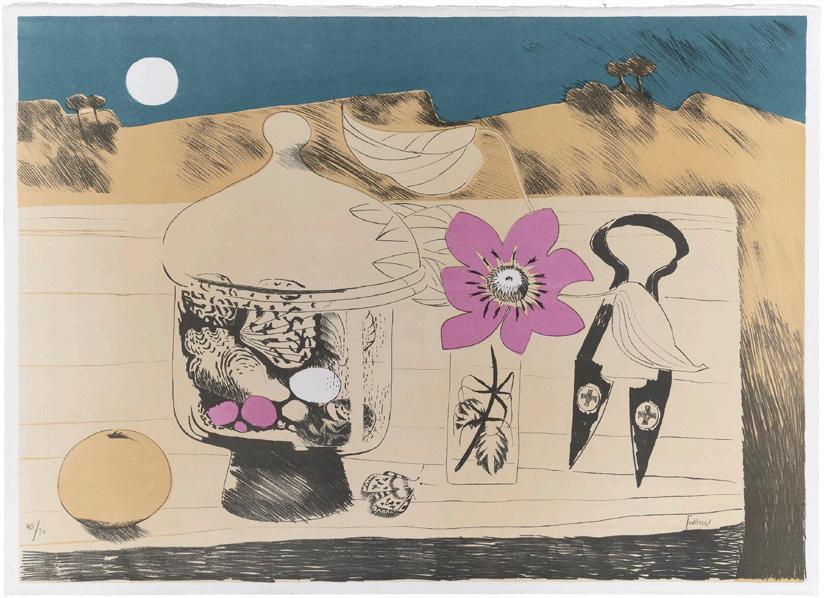
Ellis Developments Ltd.
(established 1984, Nottinghamshire, United Kingdom)
Designed by Peter Butcher
Bioimplantable device for reconstructive shoulder surgery, 1997–2004/2021
Embroidered polyester, 10 1/4 × 10 1/4 inches (framed)
Gift of Ellis Developments Ltd., 2021.32.1
Ellis Developments Ltd. creates technical textiles for medical applications as well as composite materials for large-scale engineering projects, among other work. The snowflake-like pattern of this piece, designed for reconstructive shoulder surgery, allows for the surgeon to attach the device at multiple points to the existing tissue. Made with patented machine embroidery technology, it was named one of Time magazine’s Amazing Inventions of 2005.
Mary Fedden
(born Bristol, England, 1915; died London, 2012)
Pot of Shells, 1971
Lithograph on paper, 28 1/4 × 36 inches (framed)
Gift of Steven Brier, 1980.186
Mary Fedden was a British painter and professor, and the first woman to teach painting at the Royal College of Art in 1958 (one of her students was the painter David Hockney). Fedden made still life paintings that often included arrangements of flowers, food, or in this case, seashells. Her color palette was bold and her unique style included the use of pattern on tablecloths, furniture, and wallpaper within the still lifes she worked from. The chunky and imperfect forms offer a whimsical take on everyday objects.
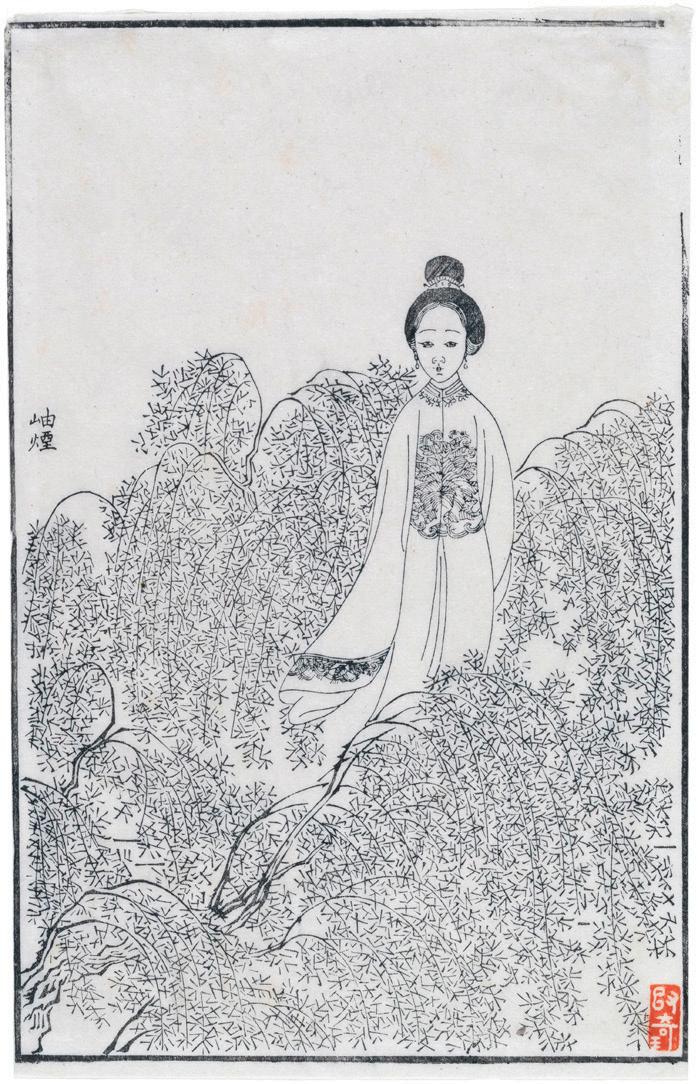
Gai Qi
(born c. 1774; died c. 1829)
Untitled (Woman Standing Among Young Willows), n.d.
Monochrome woodcut, 14 1/2 × 10 1/2 inches (framed)
Gift of Marion Pease, ND303
Repetition, patterned mark making, and negative space are all elements used to create a dynamic composition in this print of a figure in nature. The juxtaposition of hundreds of tiny lines that make up the willow leaves with the larger flat areas of negative space in the background or in the figure’s dress, create a sense of compositional balance.
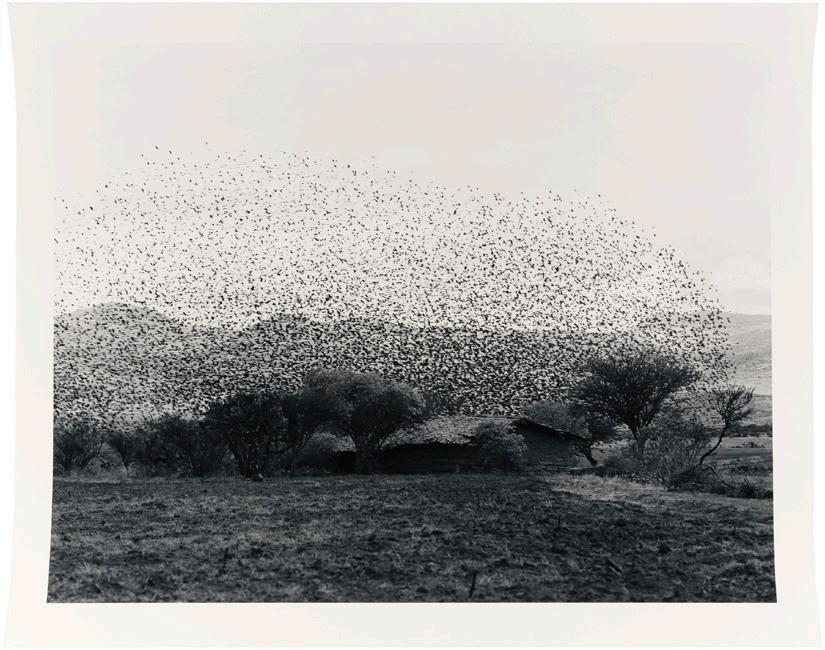
Flor Garduño
(born Mexico City, 1957)
Nube, México, 1982
Gelatin silver print, 20 ¾ × 24 ¾ inches (framed)
The Jack Shear Collection of Photography at the Tang Teaching Museum, 2020.31.122
Flor Garduño is inspired by the landscape of her native Mexico, and by its people. Working in black and white photography, she depicts the lives of indigenous peoples participating in traditional rituals, and the ephemeral beauty found in nature. Here, a massive flock of birds in a cloud-like formation is either about to take off or land from a line of trees in a field.


Nan Goldin (born Washington, DC, 1953)
self-portrait in blue dress, New York City, 1985, 1985, printed 2020
Archival pigment print, 12 × 13 ¾ inches (framed)
Gift of Ian Berry, 2020.10.4.1
“This is a picture of me in the ’80s at a friend’s after the bar. The dress was my uniform at that time. These were the days of the night life.”
—Nan Goldin
Janko Gravner (born Slovenia, 1960)
David Griffeath (born United States, 1948)
Modeling Snow Crystal Growth, 2016
Digital print on transparent film, 18 1/4 × 22 ¾ inches (framed)
Tang purchase, ED2017.1.6
Janko Gravner and David Griffeath are contemporary mathematicians interested in the intersection of science and art. This work is part of a larger body of computationally generated forms called Snowfakes, created in response to 20th-century farmer and amateur meteorologist Wilson Bentley’s revolutionary photographs of actual snowflakes. Using an algorithm to understand the formation of snow crystal patterns, Gravner and Griffeath created graphical image and video models that mimicked the process found in nature.
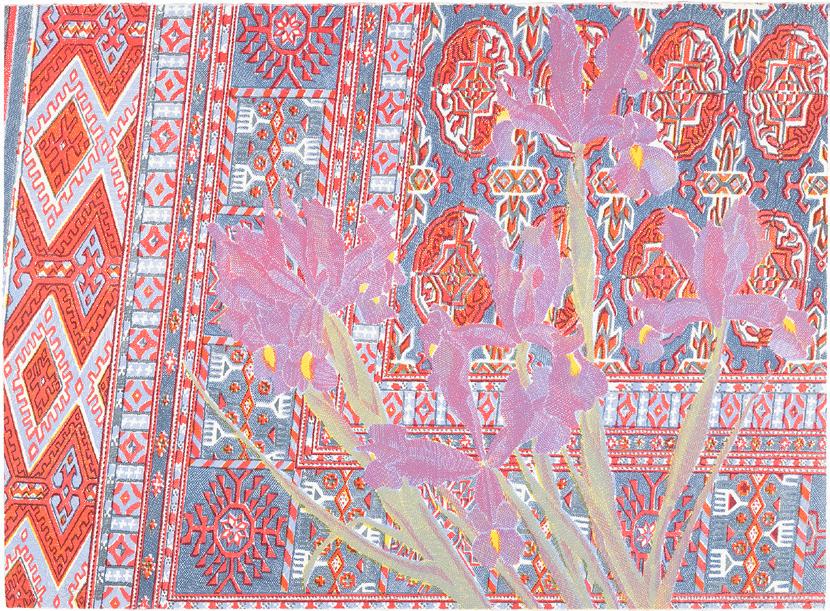
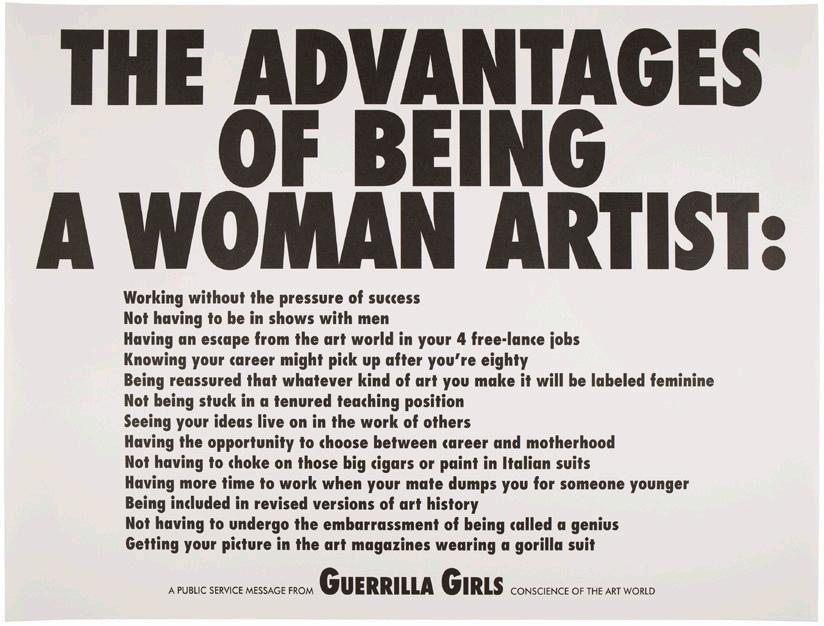
Laura Grosch (born Worcester, Massachusetts, 1945)
Iris on Bokhara, 1975
Four-color lithograph, 24 1/4 × 32 1/2 inches (framed) Gift of Dwain G. Fuller, 1984.225
Influenced by nature, botanical images, and motifs on artifacts and textiles, Laura Grosch plays with these sources to create her own patterns through printmaking and painting. Works such as this one also explore the function of color and experiment with our perception of positive and negative space.
Guerrilla Girls (established 1985)
The Advantages of Being a Woman Artist, 1988, printed later
Off-set print on paper, 19 ¾ × 24 ¾ inches (framed) Tang purchase, 2022.6
The Guerrilla Girls are an anonymous group of feminist activists who wear gorilla masks to conceal their identity in public. Devoted to fighting sexism and racism in the art world, they make posters, billboards, books, stickers, and even performances that highlight discrimination and corruption in the art world using statistics and humor.

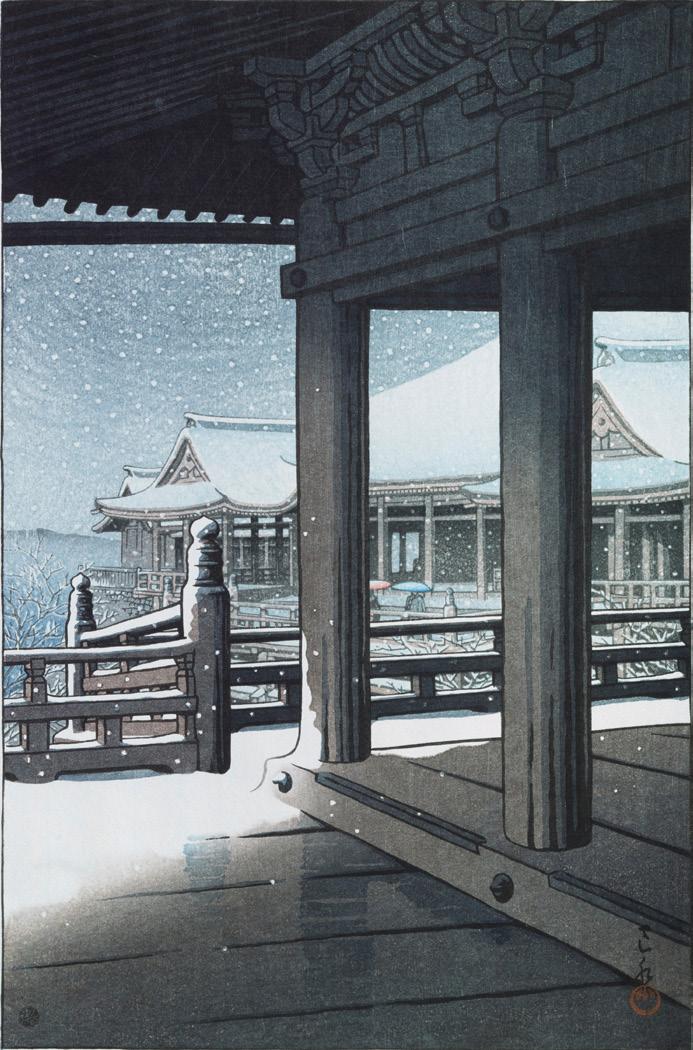
Trenton Doyle Hancock
(born Oklahoma City, Oklahoma, 1974)
Hancock’s Bringback, 2013
Etching and silkscreen, 12 ¾ × 11 ¹/8 inches (framed) Tang purchase, 2023.5
Trenton Doyle Hancock has created a narrative world inhabited by Mounds, a group of mythical creatures that are part animal, part plant, and who are engaged in the age-old struggle of good versus evil with creatures called Vegans. He tells this story through prints, drawings, installations, and collaged felt paintings. Influenced by comics, cartoons, music, and film, Doyle’s figures feel as if conjured from dreams or nightmares. In this print, candy-colored pink splotches cover areas of the black and white striped, furry face of a Bringback character whose role is to evoke nostalgia.
Kawase Hasui (born Tokyo, 1883; died Tokyo, 1957)
Evening snowfall at Kiyomizu temple (Kiyomizudera no bosetsu), 1950
Woodblock print, 21 ⁷/8 × 16 ³/8 inches (framed) Gift of anonymous donor, ED2018.1.2
Japanese woodblock prints like this one depict various scenes including Kabuki actors of the pleasure district, historical events, and romantic vistas. Such prints were often commissioned by commercial book publishers and made by designers and engravers working together to produce the prints.
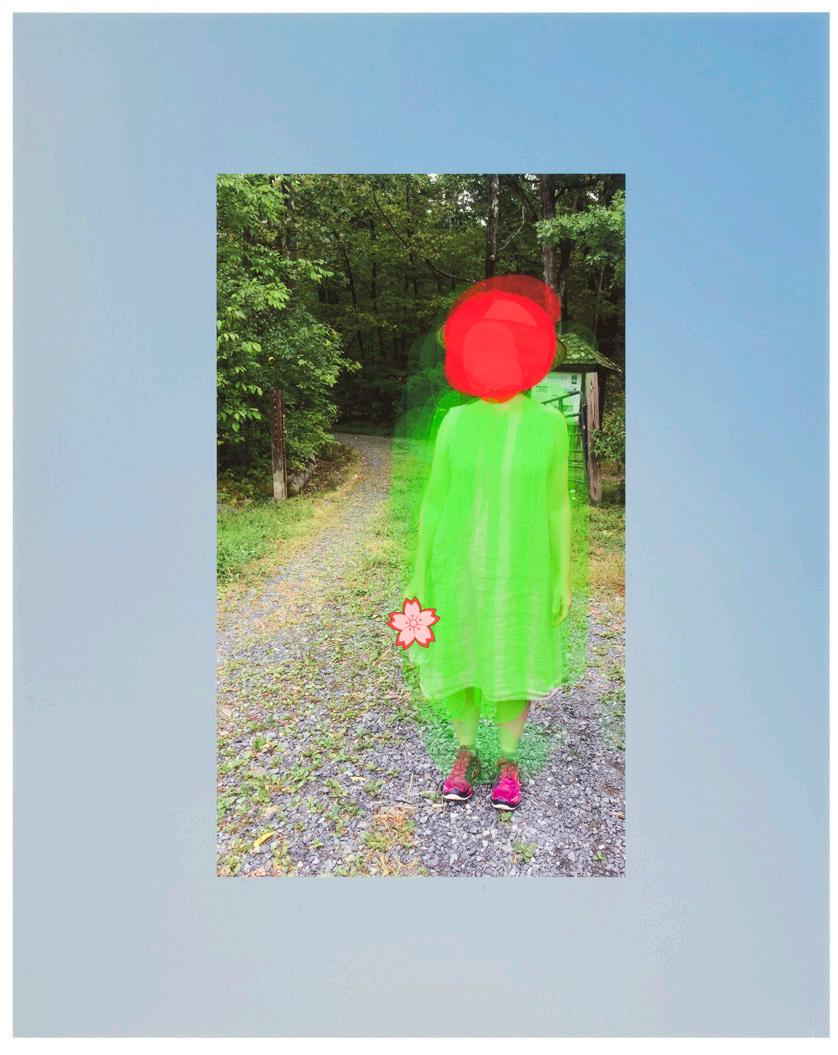
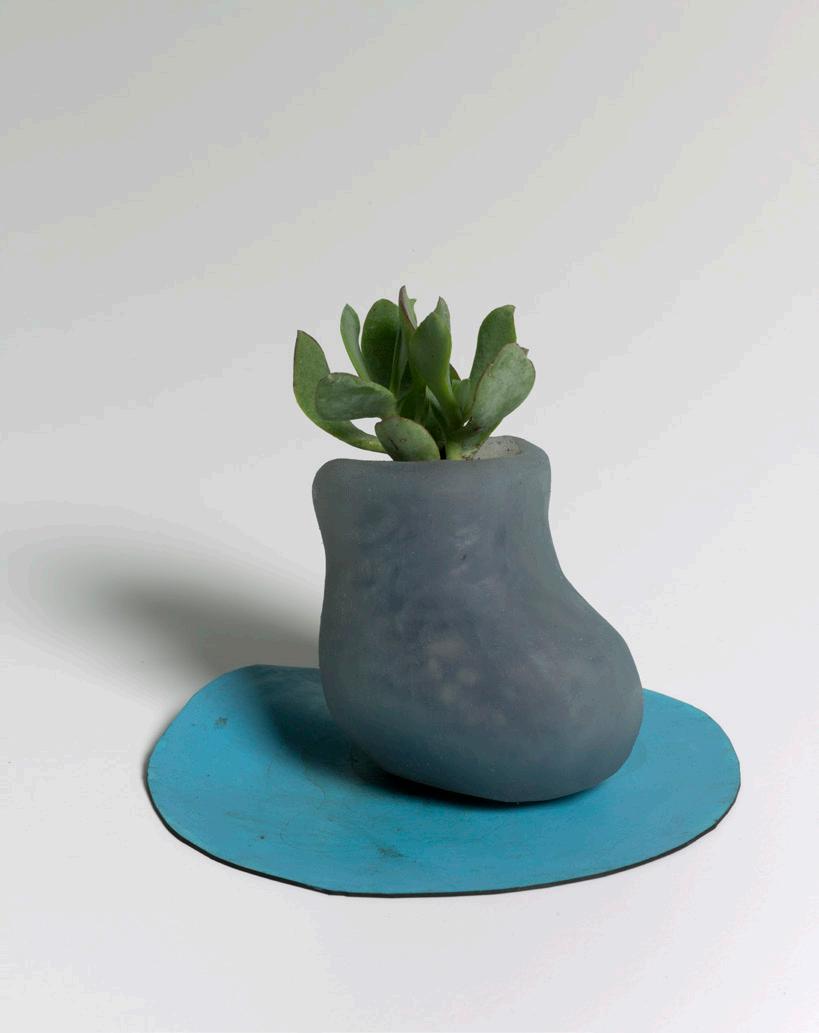
Paula Hayes (born Concord, Massachusetts, 1958)
above:
Re d Head, 2015
Archival pigment print, 10 1/4 × 8 1/4 inches (framed)
Gift of William J. Simmons and Felipe Núñez, Los Angeles/New York, 2021.13.1
right:
Untitled (Planter), c. 2009
Silicone, rubber, and paint, 3 1/2 × 6 1/2 × 6 ¾ inches
Gift of William J. Simmons and Felipe Núñez, Los Angeles/New York, 2021.13.3
A 1987 alumna of Skidmore College, Paula Hayes grew up on a farm in upstate New York. Her upbringing generated an interest in artwork made of living things that intimately connect people with nature. Hayes is an artist and designer who works in a variety of mediums, including raw material such as plants, dirt, and water to create immersive environments brimming with life.
In Red Head, Hayes combines photography, painting, and collage processes to express her fondness for nature. With Untitled (Planter), Hayes combines form and function by creating a biomorphic and whimsical sculpture that acts as a vessel for plant life. The silicone material’s natural translucence allows light to pass through its edges and to see the root system of the plants.
These works are paired together; the sculpture will contain a living plant to be cared for by whoever takes it home.

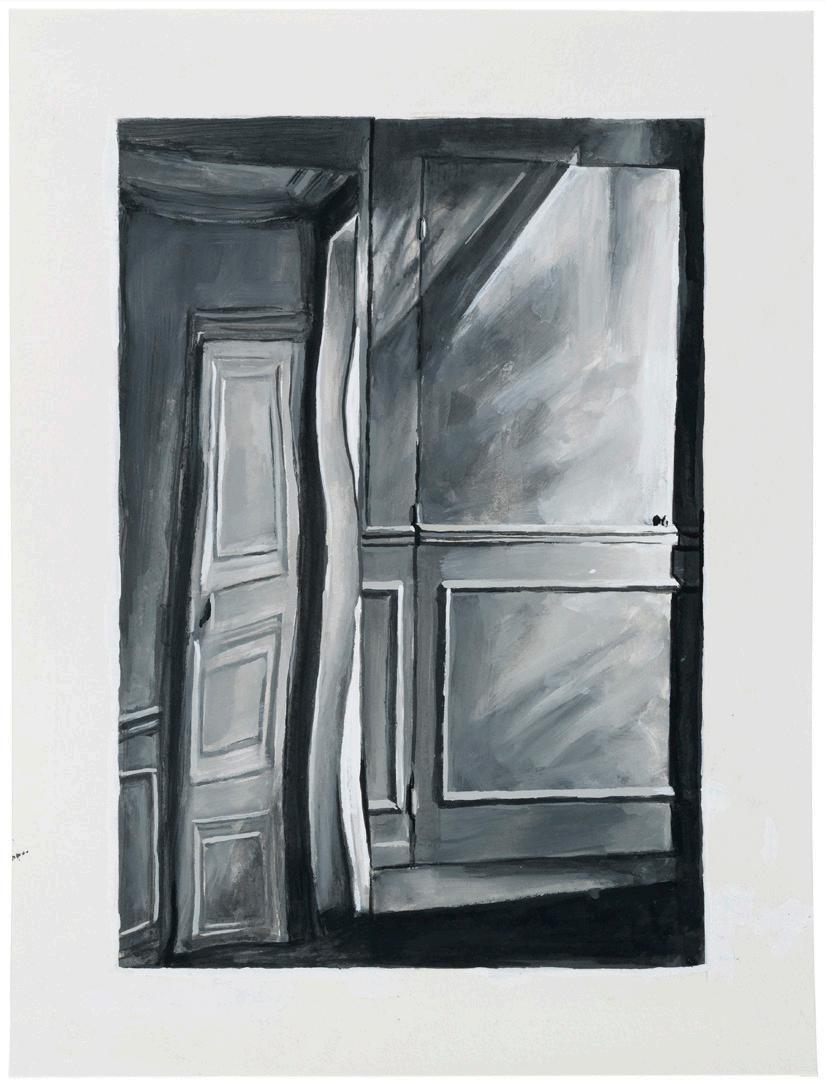
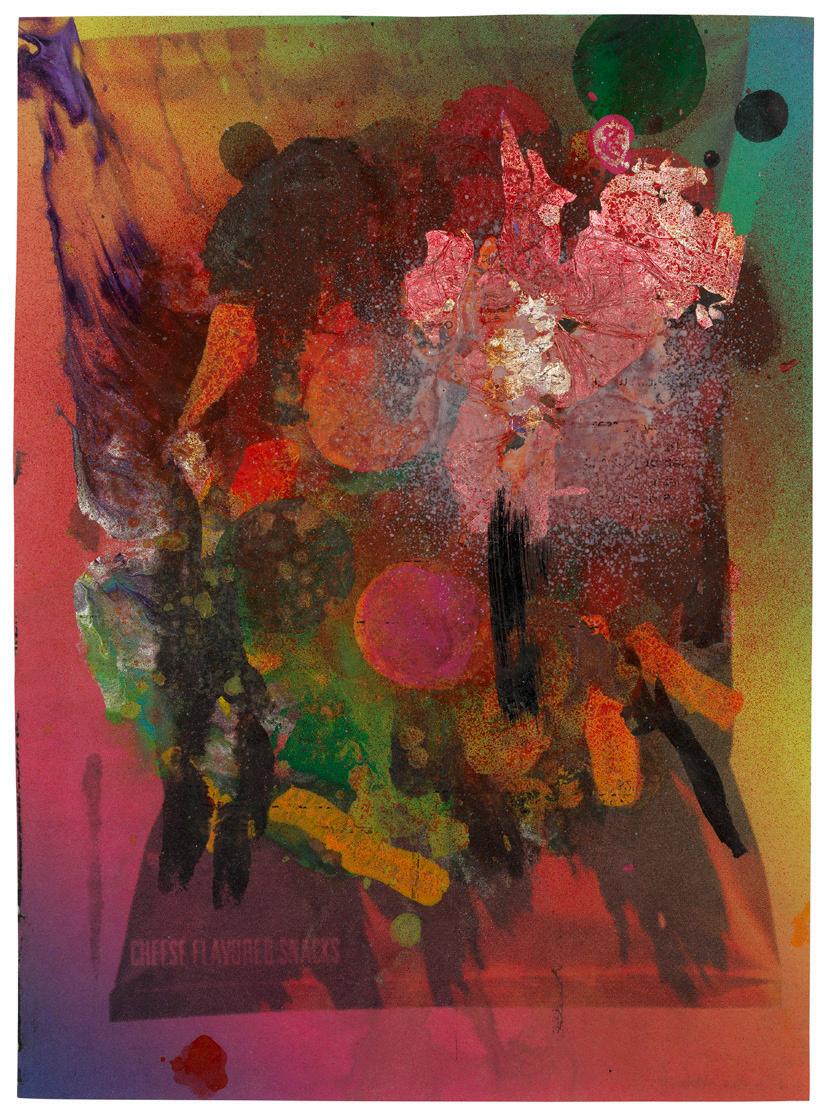
Julian Hoeber
(born Philadelphia, Pennsylvania, 1974)
Untitled (after Kertész B), 2014
Gouache and graphite on paper, 20 1/4 × 16 1/4 inches (framed)
Gift of Zach Feuer and Alison Fox, 2015.30.5
Julian Hoeber’s work is inspired by architecture, forgery, and illusion. In paintings, drawings, and sculptures, he explores color, surface, pattern, and distortion. The title of this work references a photograph taken by photographer André Kertész titled Paris Door from 1984. Hoeber’s painting is based on the Kertész photograph, which captures a door in a Paris interior as seen reflected by an incredibly wavy mirror. The painting of the photograph is another layer of reflection or repetition of the door, further abstracting a physical object and transforming it into undulating lines and pattern.
Tom Holmes (born Ozona, Texas, 1975)
untitled Chip Bag, 2011
Acrylic, ink, silver leaf, inkjet on paper 16 7⁄8 × 13 3⁄4 inches (framed)
Gift of Anne and Arthur Goldstein, 2015.3.7
Tom Holmes is an abstract painter who includes seemingly mundane, everyday objects like chip bags, cereal boxes, milk containers, and folding chairs in his work. These objects reference everyday US culture, but through his work, they are transformed into studies of formal elements such as line, color, and texture.


Patrick Hughes
(born Birmingham, England, 1939)
Untitled, from The Domestic Life of the Rainbow, 1979
Screen print on 280 gsm BFK Rives paper 12 3⁄4 × 14 3⁄4 inches (framed)
Gift of Marvin A. Sackner, 1981.155.2
This work is from a portfolio of prints titled The Domestic Life of the Rainbow. The set depicts rainbows stretched through windows, hung over a chair, sneaking out the door, and flowing out of a paint can. These vibrant pop art prints combine clever optical tricks and jokes with a whimsical, playful subject matter.
Mary Reid Kelley
(born Greenville, South Carolina, 1979)
Untitled (Character drawing, Sadie for “Sadie, The Saddest Sadist”), 2009
Ink on paper, 9 ¾ × 12 1/4 inches (framed) Gift of Anne and Arthur Goldstein, 2015.3.29
Mary Reid Kelley makes monochromatic videos, drawings, and collages, and in her videos she adopts multiple personas and builds meticulous sets and costumes. As the starring character, she dons the costumes and wears elaborate makeup. This painting is a study for the character Sadie, a munitions worker, in Sadie, the Saddest Sadist. Set in London in the First World War, Kelley uses a feminist slapstick to reveal and reassess Women’s place in history.


Jenny Kemp
(born Sheboygan, Wisconsin, 1979)
Night Thread, 2019
Woodblock print, 20 1⁄8 × 15 5⁄8 inches (framed)
Gift of Jenny Kemp, 2019.57
Jenny Kemp makes abstract paintings inspired by natural imagery, resulting in layers of colors radiating, repeating, and weaving in and out of one another. Night Thread was made during her time at Skidmore College as a visiting artist in the Skidmore Summer Studio Art Program. As part of the course “Translations and Conversations: Printing with Artists,” Kemp made a single drawing that generated a series of prints, each with its own color palette.
Corita
Kent
(born Fort Dodge, Iowa, 1918; died Boston, Massachusetts, 1986)
if i, 1969
Serigraph, 27 7⁄8 × 16 3⁄4 inches (framed)
Gift of Harry Hambly, serigrapher, Hambly Studios, 2016.14.176
Corita Kent created eye-popping screen prints that combine corporate logos with excerpts from some of the artist’s favorite writers and speakers, creating an intersection between religious euphoria and advertising hyperbole. In this work, Kent quotes British philosopher Alan Watts.
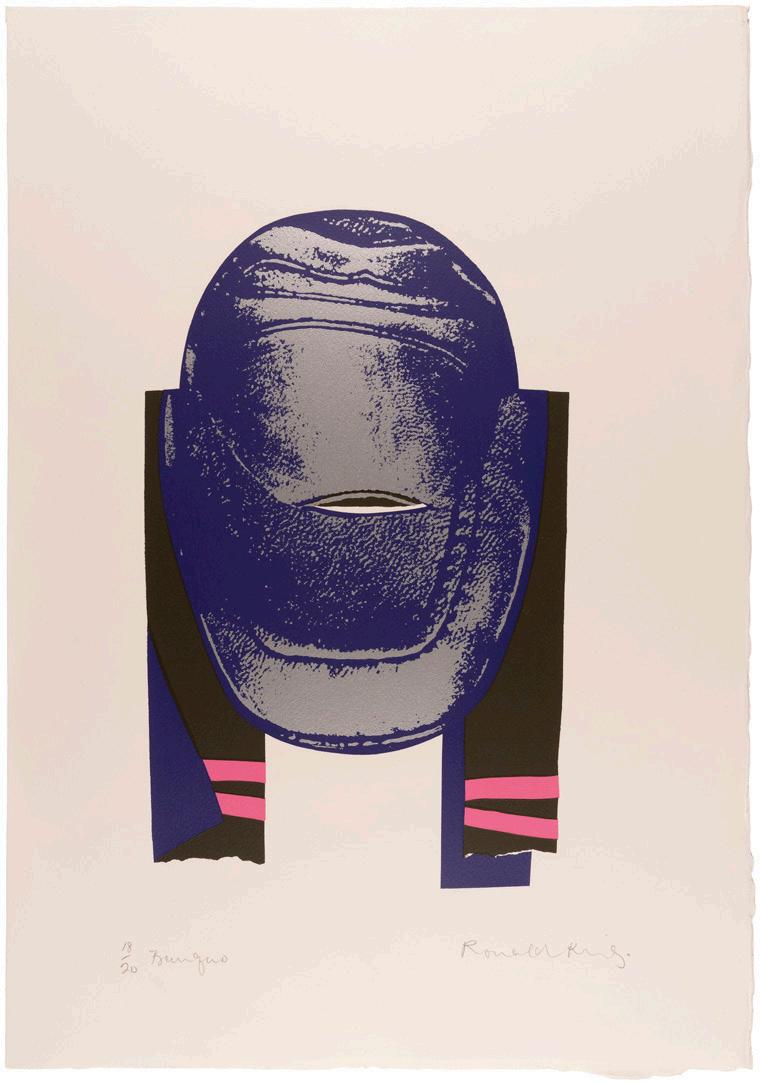
Ron King
(born São Paulo, Brazil, 1932)
Banquo, from the series Macbeth, 1970
Screen print, 27 × 19 1/2 inches (framed) Gift of James Dye, 1981.145
Ronald King is a painter, sculptor and bookmaker, and Banquo is one of ten silk screen mask designs named after a character in Shakespeare’s Macbeth. This piece was made through a process of collage and printmaking. King began by collecting images from magazines like the tip of a shoe, and other found photographs which he then used to collage with. Once the collage was completed, he used silkscreen techniques to create a photo-stencil from which he could make multiple prints.
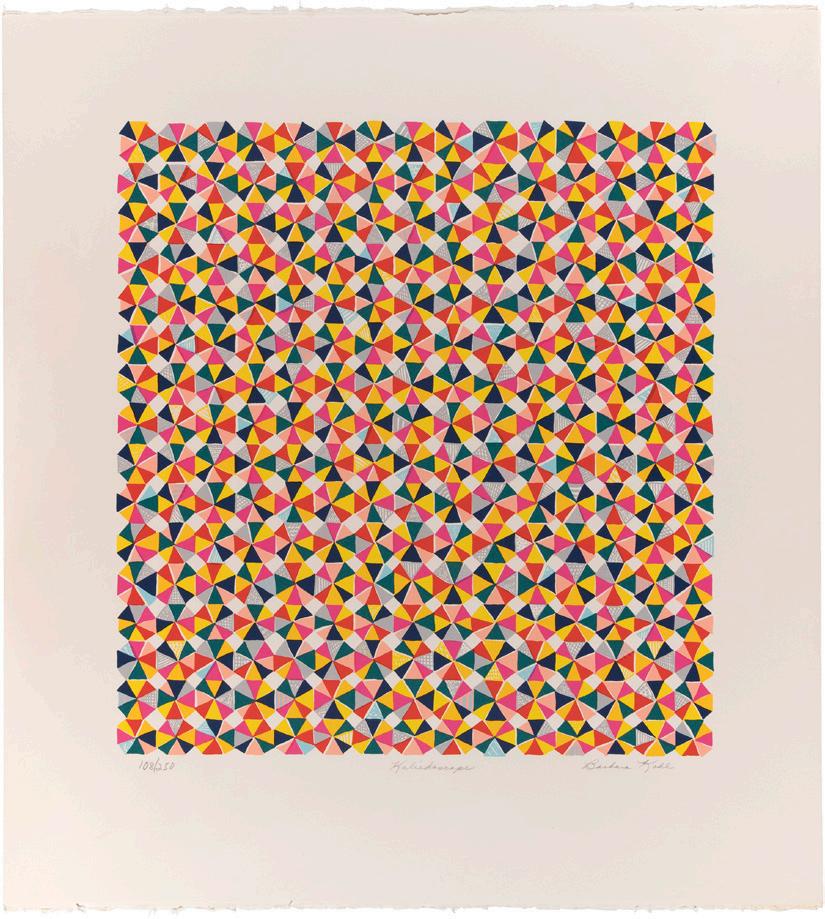
Barbara Kohl Spiro (born Milwaukee, Wisconsin, 1940)
Kaleidoscope, 1979
Screen print, 24 1/4 × 23 1/2 inches (framed) Gift of Leon N. Nad, 1984.490
Influenced by quilt patterns and the Op Art movement of the 1960s, Barbara Kohl Spiro makes colorful geometric paintings, prints, and collages. The title of the work Kaleidoscope is a direct reference to a traditional quilting pattern which consists of sewing together slivers of fabric to create elliptical patterns that appear to shift.
“I am Jewish and my tradition teaches the importance of thinking of generations to come. I think of the legacy given to me by all the great artists of the past. To me many of these artists were women—often anonymous, often part of the decorative arts. I hope I can be a small part of the creative people's legacy.”
—Barbara Kohl Spiro
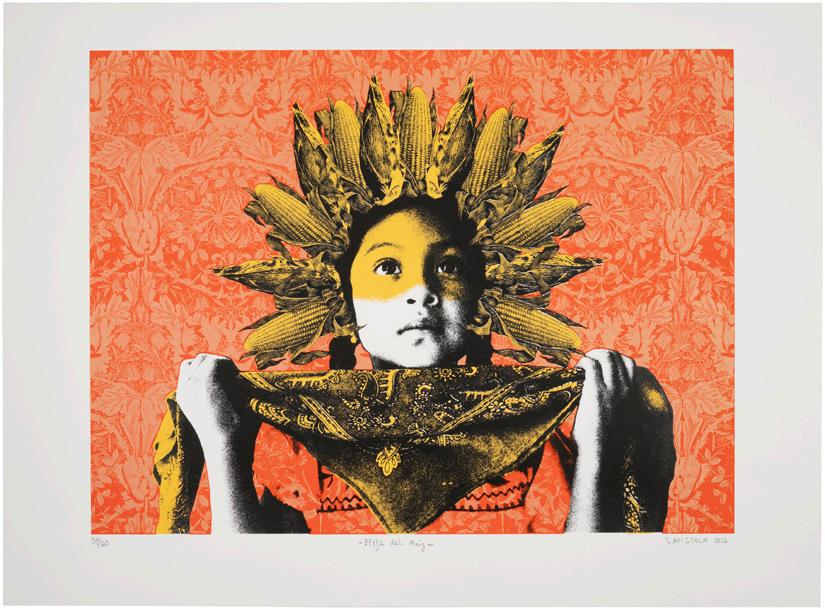
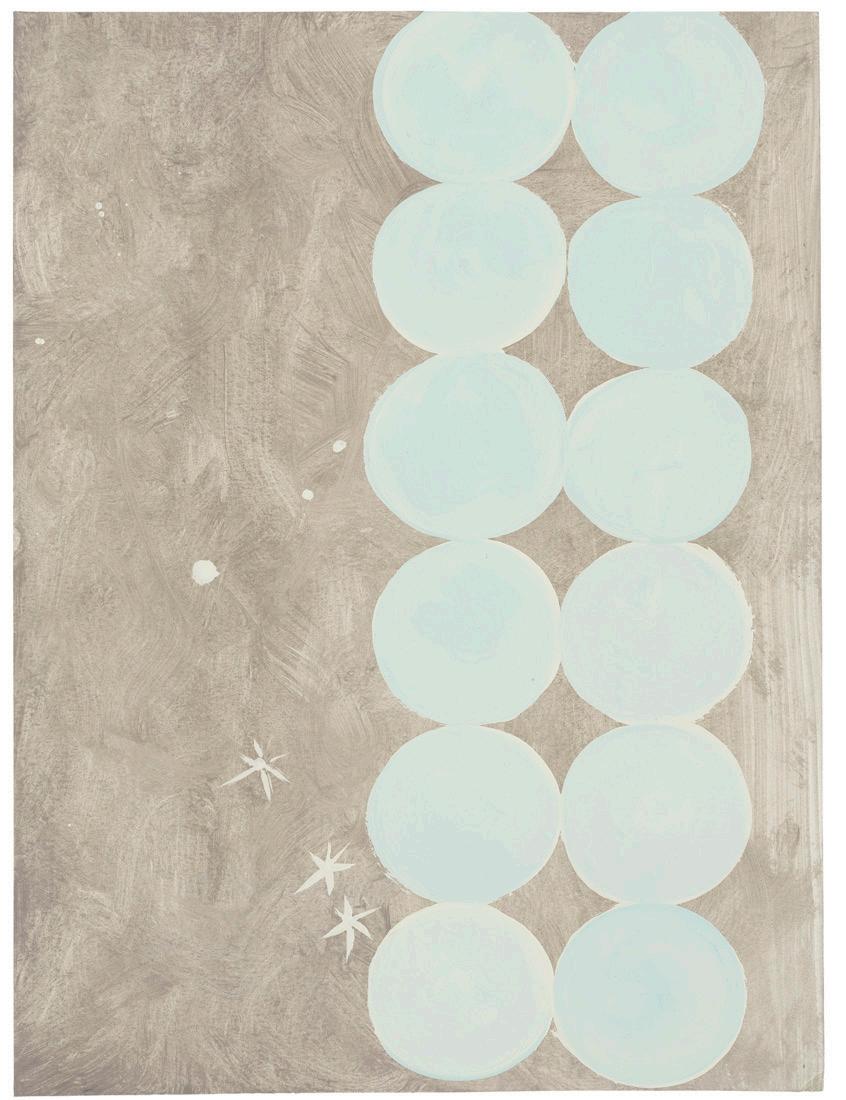
Lapiztola (established Oaxaca City, Mexico, 2006)
Hija Del Maiz, 2022
Serigraph, 26 × 32 inches (framed) Tang purchase, 2023.4.1
Lapiztola is a collective consisting of designers Roberto Vega and Rosario Mtz and architect Yankel Balderas. The collective was born in Oaxaca City, Mexico, after a string of protests against the corrupt government that lasted 6 months and resulted in a teacher’s union who forced the police out of the city. These events helped form their name Lapiztola: lapiz is the Spanish word for pencil while pistola means gun. The artworks exist as prints on paper and large-scale murals that speak of their outrage with the government, drug lords, and even genetically modified foods.
Judy Ledgerwood (born Brazil, Indiana, 1959)
Cold Days (vertical #12), 1999
Acrylic pearl, Flashe on paper, 21 ¾ × 16 ¾ inches (framed) Gift of a private collection, 2019.15.2.1
Influenced by decorative art, textiles, and other traditionally feminine crafts, Judy Ledgerwood uses repetitive patterns and symmetry to create abstract paintings. In this work, 12 circles are stacked on top of each other in a muted, cool, and iridescent palette, topped with three star-like snowflakes. The use of color and the glittery quality of the paint are reminiscent of winter light.


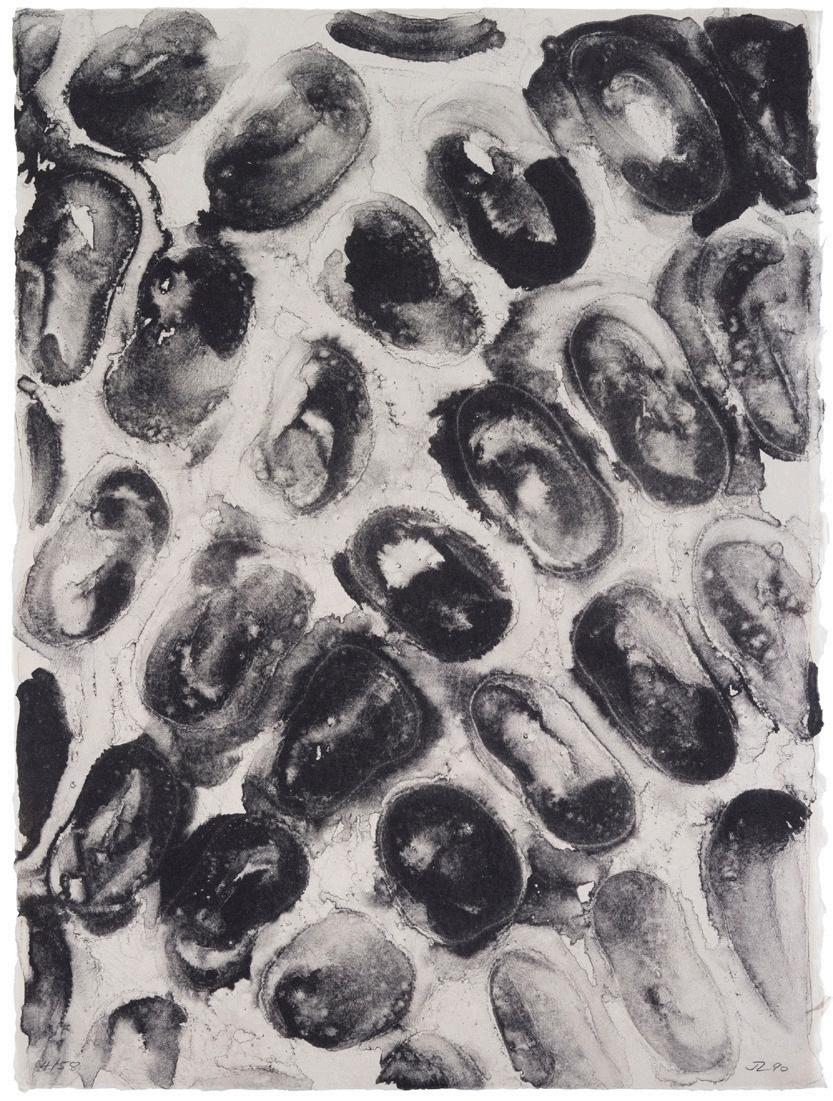
Margaret Lee
(born Bronx, New York, 1980)
Watermelon Boot (anticipation or something), 2011
Color photograph, 24 1/4 × 29 1/4 inches (framed)
Gift of Eileen and Michael Cohen, 2022.25.15
Margaret Lee makes hyper-realistic sculptures that on first inspection appear to be real items, taken directly from nature, such as a watermelon, a potato, or a cucumber. Unlike a ready-made that has a manufactured appearance, each watermelon from this series is made from a mold and then hand painted, thus each one is unique. Lee often pairs the fruit with other seemingly random objects, in this case, with a boot—which may or may not be “real.”
Julian Lethbridge (born Colombo, Sri Lanka, 1947)
Untitled, 1990
Lithograph on handmade kurotani paper
29 3⁄4 × 23 7⁄8 inches (framed)
Gift of Jack Shear, 2020.1.2
Julian Lethbridge, who was educated as a banker before moving to New York City to paint, is influenced by mathematical and natural principles. His process often begins with building up the composition with gestural patterns in pigment and then incising the same pattern over them. The artist limits his palette to black and white and the natural color of Japanese paper.


Sol LeWitt
(born Hartford, Connecticut, 1928; died New York, New York, 2007)
Brushstrokes: Horizontal and Vertical, Plate #13, 1996
Color lithograph on paper, 13 1/4 × 15 ¾ inches (framed)
Gift of Peter Norton, 2014.7.36.14
Sol LeWitt was a founder of the conceptual art movement, which emphasized that the artist’s idea is the artwork, rather than something they create with their own hands. LeWitt created sets of instructions which others could follow to create his artworks. His methods were mathematically based, defined by language, or created through random processes, and his works exist as massive wall drawings in graphite, pen, marker, or paint, as well as on paper, like Brushstrokes: Horizontal and Vertical. Although the artist rarely executed his own work, this lithograph, one of a set of 25, is based on an original gouache painting made by the artist himself.
Roy Lichtenstein
(born New York, New York, 1923; died New York, New York, 1997)
Modern Art Poster, 1967
Screen print on paper, 15 × 17 1/2 inches (framed) Gift of Joel and Ann Berson, 2017.49.13
One of the founders of the pop art movement, Roy Lichtenstein made paintings based on blown-up comic strips and advertisements. Lichtenstein imitated the Benday dots from newspaper and print reproductions and the dots became iconic in his work. These works were a critique of consumer industry in a new and radical way.
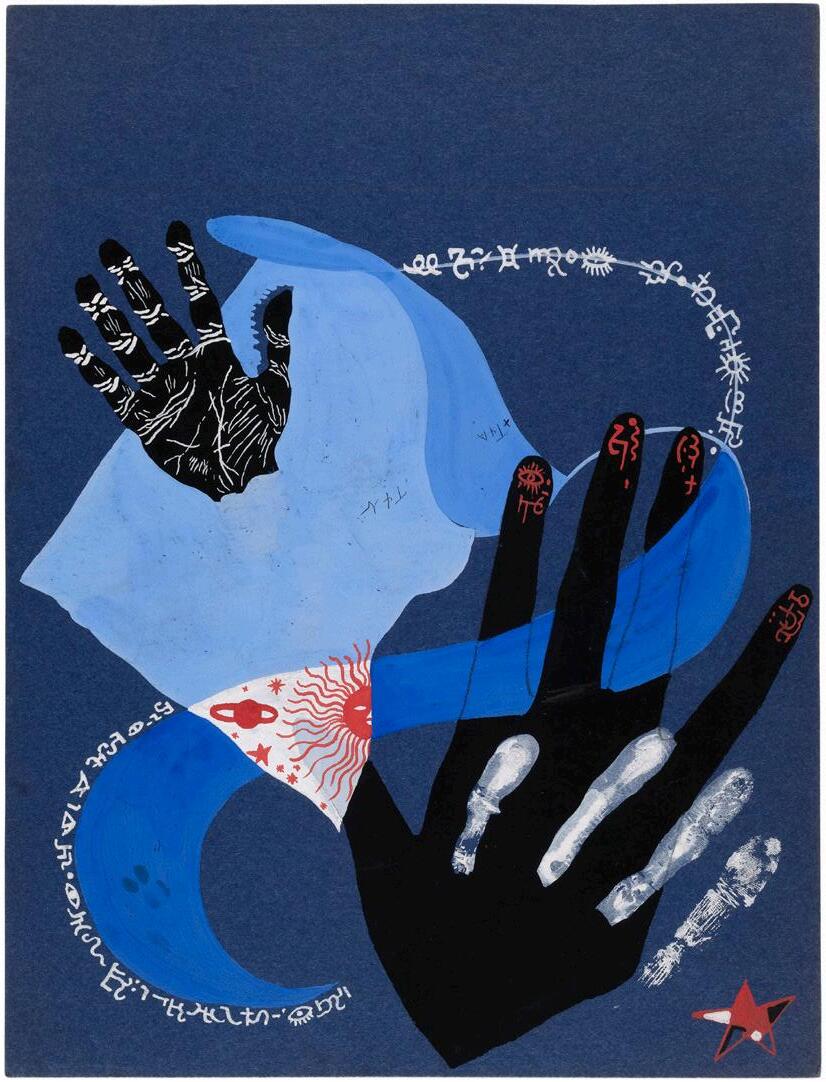

Jean Lurçat
(born Bruyères, France, 1892; died Saint-Paul-de-Vence, France, 1966)
Untitled (possible design for ballet), n.d. Gouache, 16 1/4 × 13 1/4 inches (framed)
Gift of Dorothy Dehner, Class of 1952, 1977.29
Jean Lurçat was a painter, ceramicist, and tapestry designer who was influenced by Cubism, particularly the work of Pablo Picasso and Georges Braque. He eventually developed a unique style combining representational motifs of nature, animals, and the cosmos, with modernist modes of abstraction such as fragmentation of time and space, expressive colors, and gesture.
Lisa Mackie (born Detroit, Michigan, 1947)
Madagascar, 1975
Color lithograph, 25 ¾ × 33 ¾ inches (framed) Donor unknown, 1984.408
Lisa Mackie makes paintings, prints, videos, and installations that are a compilation of memories, collected imagery, and written text. Madagascar is from a series of prints in which a reoccurring figure can be seen gazing at crystals or placed in a dreamy environment where additional figures often subtly emerge from the background.
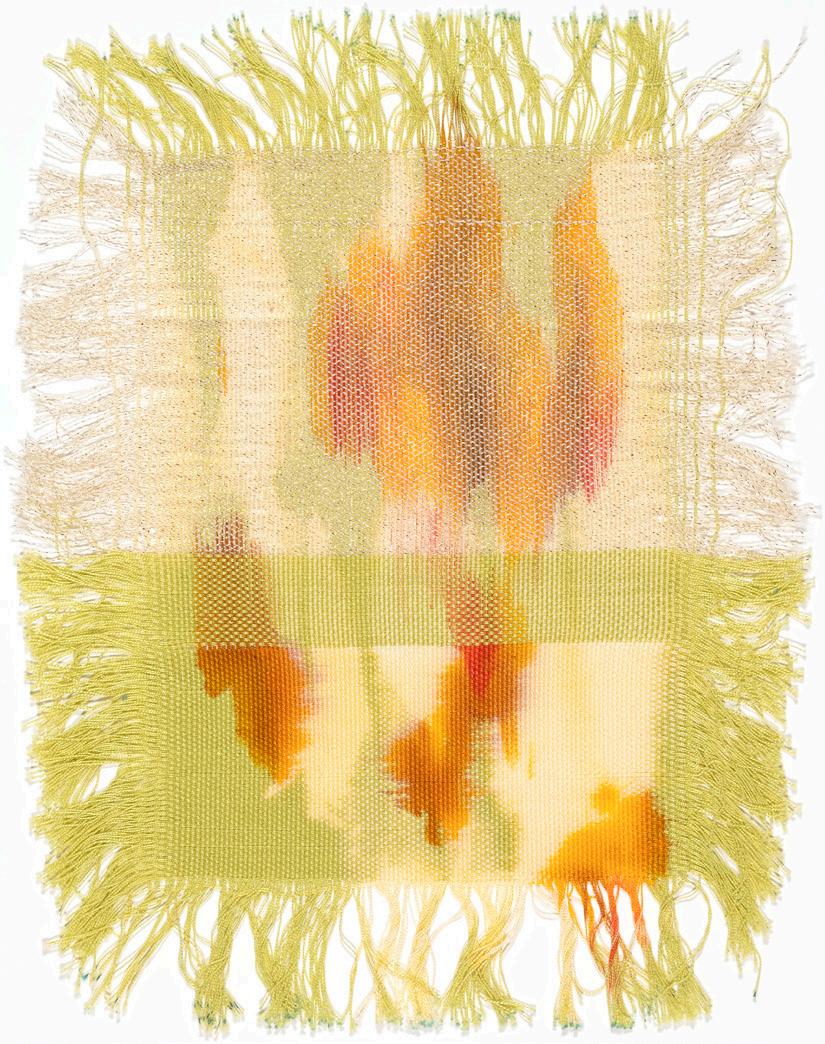
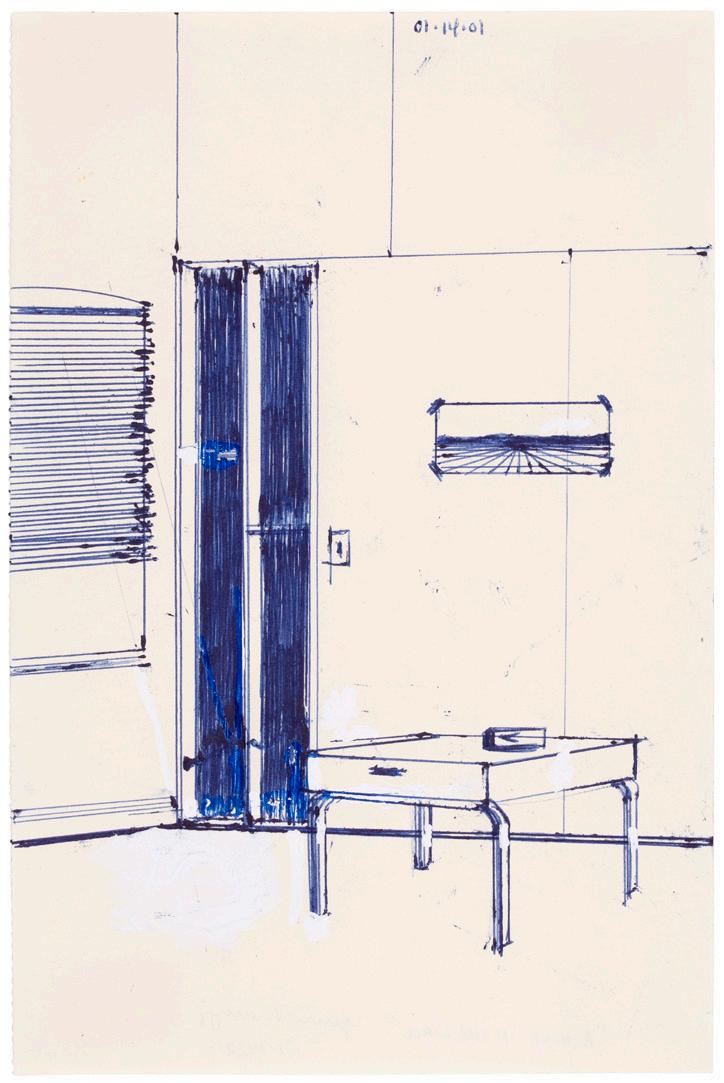
Victoria Manganiello (born Brooklyn, New York, 1989)
Untitled #82, 2015
Natural and synthetic fiber and dye 20 × 17 1/4 inches (framed)
Gift of the artist, 2022.9
Victoria Manganiello creates textiles and installations through a handmade process of spinning, weaving, and dying cotton, silk, and other natural and synthetic materials. In Untitled #82 the materiality of the fibers she chooses influences her process, where synthetic metallic threads are woven next to naturally dyed ones.
Yuri Masnyj (born Washington, DC, 1976)
A Hole in the Wall, 2001
Ballpoint pen and Wite-Out on paper 10 1/2 × 7 ¾ inches (framed)
Gift of Jay Gorney and Tom Heman, 2021.28.14
Yuri Masnyj intricately depicts minimalist interior spaces to interrogate how architecture can serve as a stage for objects inside of it. The interior we see in A Hole in the Wall, drawn in blue ball point pen, is sparse. But through its small details—the tape on the corners of the poster and the repetitive lines that make up the blinds—suggests a human presence.


Henri Matisse
(born Nord, France, 1869; died Alpes-Maritimes, France, 1954)
Palme blanche sur fond rouge, 1946–1947, published 1978
Lithograph, 27 1/4 × 22 ¾ inches (framed) Gift of Richard Levine, 2003.1.2.11
A leader of the Fauvist movement, Henri Matisse used hot colors and rejected the notion that art should be an illusion of reality. Instead, he was inspired by the everyday world of family, plants, and animals to create his own new world within the artworks.
Rita McBride
(born Des Moines, Iowa, 1960)
More Heimat mit Funkturm, 1999
Iris print on paper, 25 ¾ × 19 1/2 inches (framed) Gift of a private collection, 2019.15.2.3
Rita McBride combines her knowledge of architecture and industrial materials to create large-scale sculptures, installations, and public art. McBride is interested in engaging with the public by redefining pre-existing forms that are often overlooked in our environment. In this print, McBride confuses our sense of space with a lace pattern, a brick wall, flowers and a tree stump.

To my favorite roommate—quiet, neat, and gave the warmest welcome whenever I walked in. This pop of red was the last add-on to our senior year apartment; it was brought to us with luck and sent us off with the bang we didn’t realize we needed.
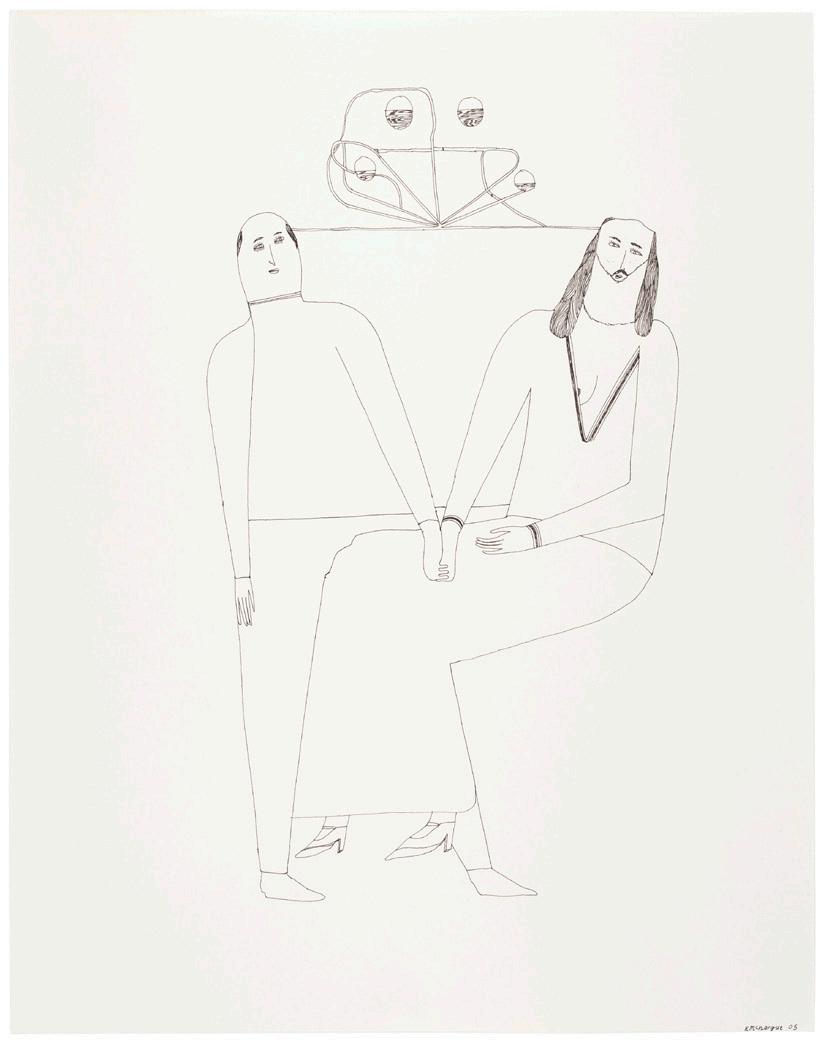
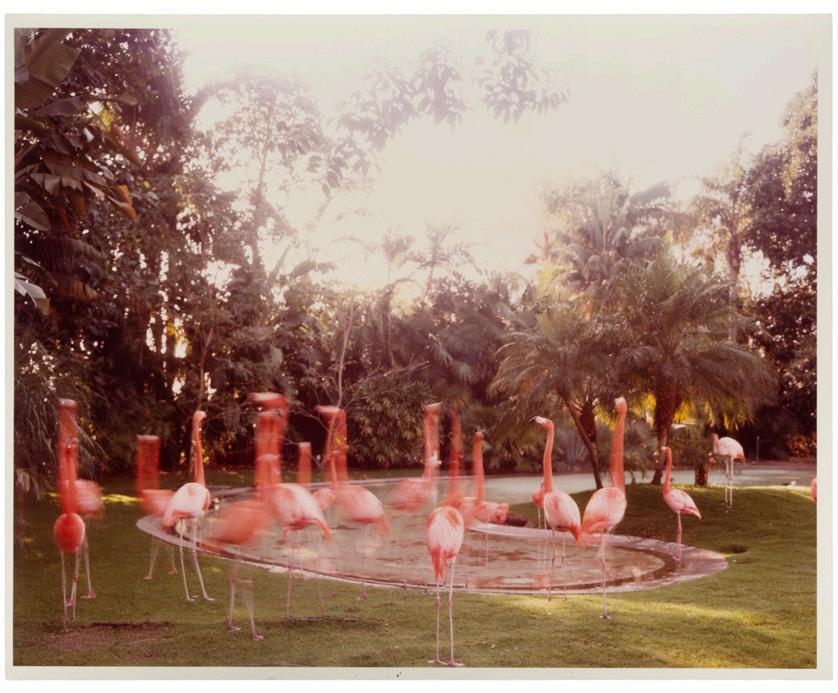
Keegan McHargue (born Portland, Oregon, 1982)
Untitled, 2005
Ink on paper, 16 1/4 × 13 1/4 inches (framed)
Gift of Jay Gorney and Tom Heman, 2021.28.16
Keegan McHargue is a self-taught artist who makes paintings and drawings that explore the humor and tragedy of everyday life. The figures in this work sit together holding hands, legs intertwined, while a series of lines and bubbles connect from one head to the other as if portraying a conversation. The flatness and childlike style of the drawing reflect the awkward and sweet reality of human experience.
Joel Meyerowitz
(born New York, New York, 1938)
Flamingos, San Diego, 1984
Chromogenic contact print, 14 × 15 7⁄8 inches (framed) Gift of M. Robin Krasny in honor of Elizabeth Gronquist, Class of 2011, 2016.24.38
Joel Meyerowitz is a street photographer and early advocate for color photography in an artistic genre that, throughout much of the 20th century, prioritized black-and-white work. He believed color added to the overall spirit of a work. In this work, Meyerowitz captures a nostalgic moment of San Diego in the 1980s and the whimsy of a group of pink flamingos, their blurred quality suggesting a fleeting presence.
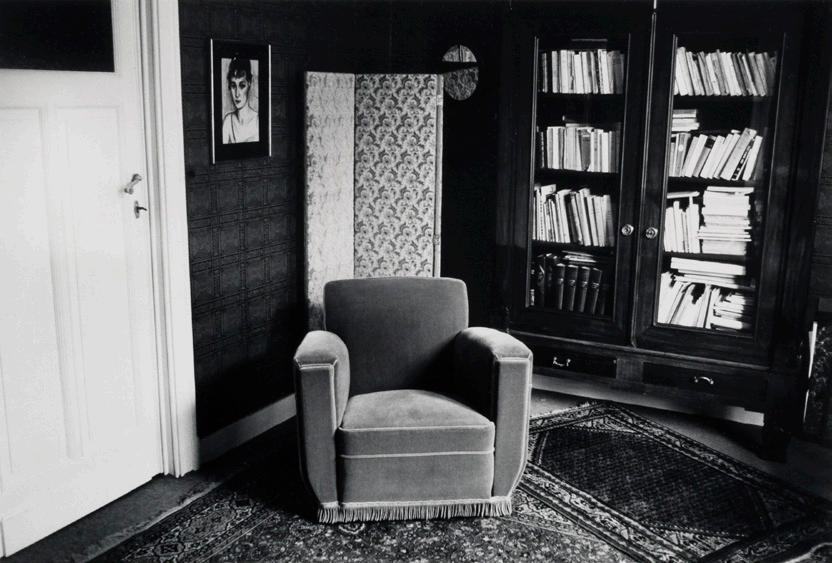
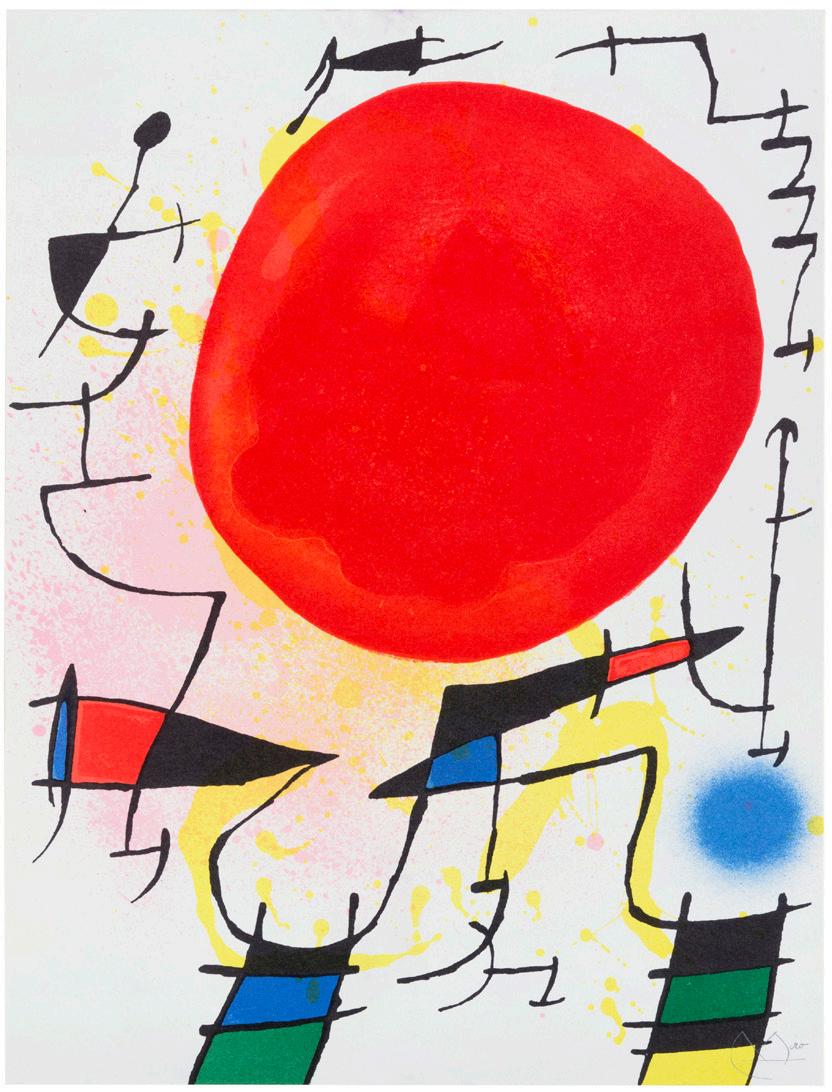
Duane Michals
(born McKeesport, Pennsylvania, 1932)
Untitled (Magritte’s Living Room), 1965
Gelatin silver print, 13 7⁄8 × 17 inches (framed)
Gift of Eileen and Michael Cohen, 2022.25.10
Duane Michals is a photographer who works in series to build narratives about mortality, intimacy, and memory. In this photograph we see the living room of painter René Magritte which offers a glimpse into the private life of this surrealist artist. The opportunity to photograph and visit Magritte’s home in Brussels was monumental to Michals who was greatly influenced by the surrealist movement, particularly their interest in, and depiction of, dreams and dream-like imagery.
Joan Miró
(born Barcelona, 1893; died Palma de Mallorca, Spain, 1983)
Sun, published 1978
Lithograph, 20 1/2 × 17 1/2 inches (framed)
Gift of Richard Levine, 2003.1.3.13
A leader of the Surrealist movement, Joan Miró aimed to challenge traditional painting and the bourgeois society that supported it. He embraced “psychic automatism,” a way of making art through channeling the unconscious mind, and he created his own symbolic language that referenced life around him.

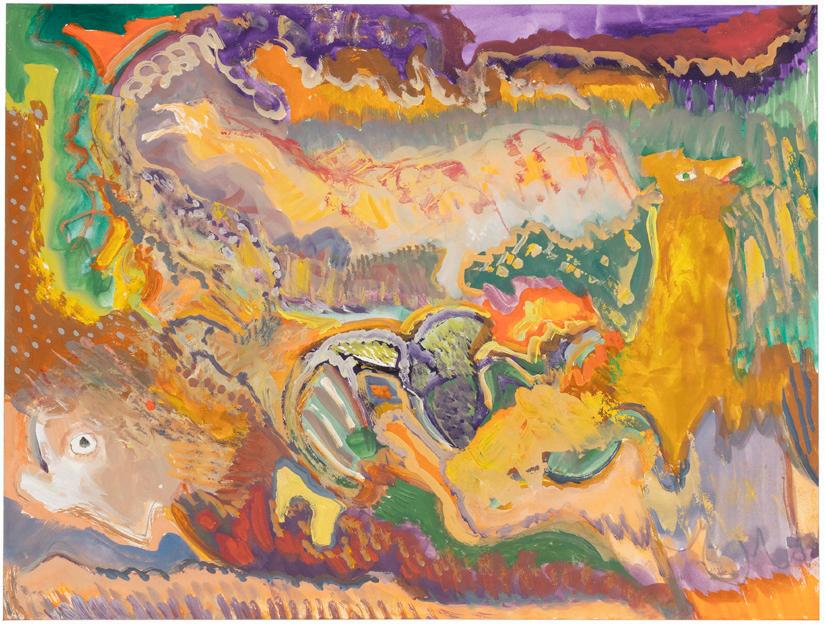
Yvette Molina
(born Kansas City, Kansas, 1972)
O.M.G., 2023
Giclee print with gold leaf on paper 19 ¾ × 16 1/2 inches (framed)
Gift of Jessica Eisenthal ’03, 2023.10
Yvette Molina is a contemporary multimedia artist who draws upon her indigenous Mexican heritage and current political issues as inspiration for her work. Molina’s work spans a variety of mediums including paintings, wearable pieces, paper clay sculptures, and other mixed-media artworks. O.M.G. is part of New Pantheon, a series of reimagined, hybrid saints and deities whose domains reflect the needs of our 21st-century world.
Bascha Mon (born Newark, New Jersey, 1932)
MAYBE A BIT OF SCHMALTZ BUT DEFINITELY NOT THE SUPER BOWL, 2023
Carbon pencil and gouache on paper 16 ¾ × 20 1/2 inches (framed)
Gift of the artist, 2023.7
Painterly brushstrokes and lavish color are distinguishing features of Skidmore alumna Bascha Mon’s expressive works. Working in painting, sculpture, and installation, Mon draws inspiration from the imagery of her everyday life and the daily news, filtering these images through layers of abstraction and representation to create unique and delicately balanced works of art. In this work, purples, greens, and yellows dance around one another, creating shapes and faces that pull the viewer in while simultaneously denying any concrete definitions.

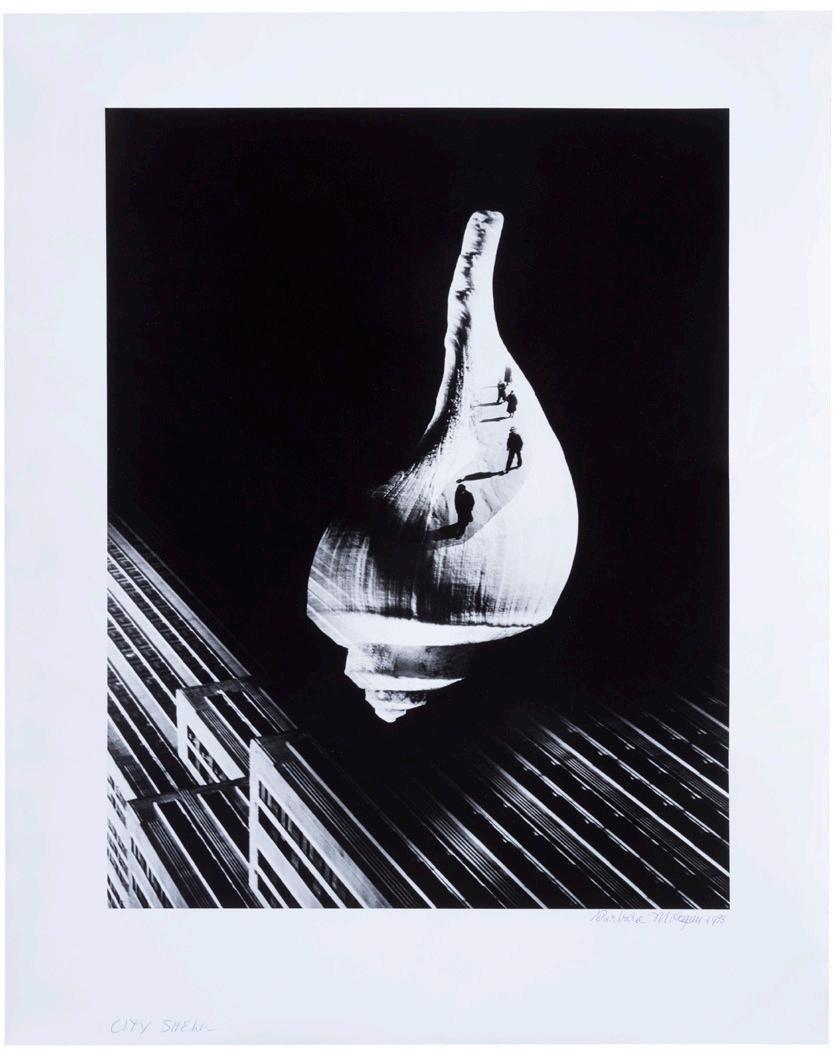
Frank Moore
(born New York, New York, 1953; died New York, New York, 2002)
Drawing for dance or theater production, probably 1980s
Pigment on paper, 15 × 13 ¾ inches (framed)
Gift of the Gesso Foundation, 2016.20.34
Frank Moore was an artist and activist who made paintings about the world around him, focusing on its natural beauty as well as its pressing ecological concerns. Moore began collaborating within the theater world in the 1980s, where he created costumes and set designs. The sketches like this one, that he made during this time, depict characters dancing and posing in his costume designs.
Barbara Morgan
(born Buffalo, Kansas, 1900; died North Tarrytown, New York, 1992)
City Shell, 1938, printed c. 1980
Gelatin silver print, 24 1/4 × 20 1/4 inches (framed)
Gift of L. Bradley Camp, 1984.237
Barbara Morgan is well known for her photographs of modern dancers and her ability to portray the subjects’ emotions. In City Shell, she experiments in photomontage, a process in which the artist cuts up photographs and layers them on top of one another to create new compositions.
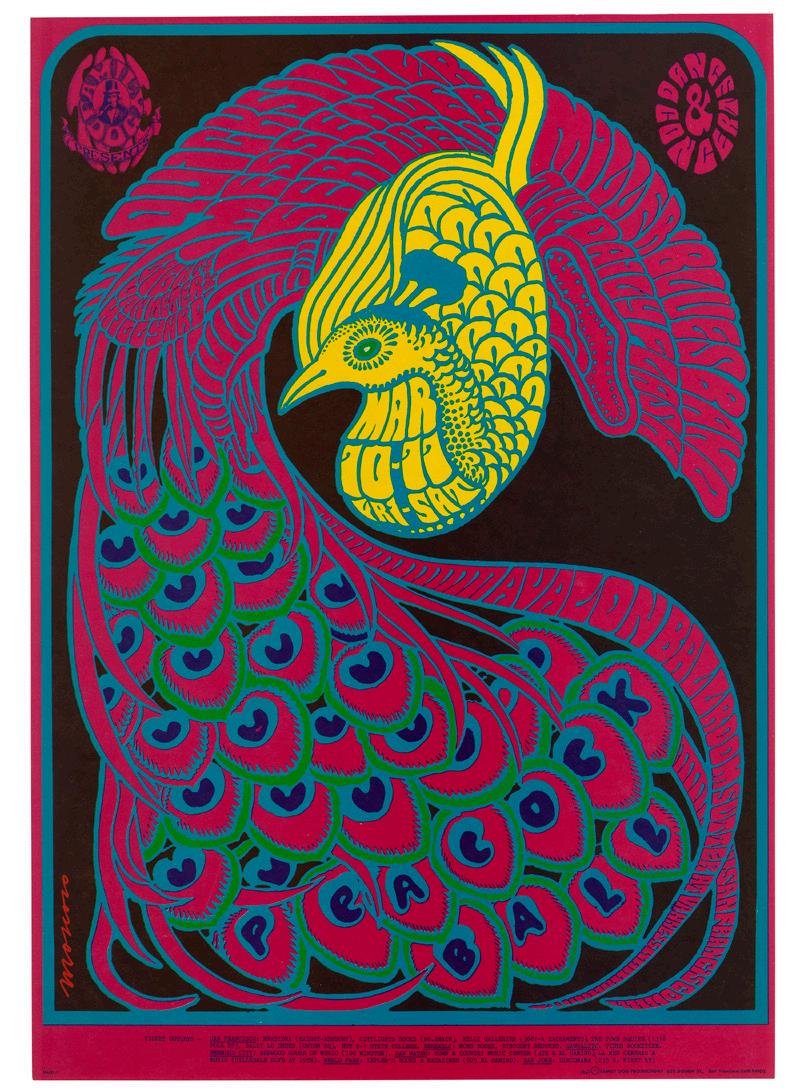
Victor Moscoso
(born Oleiros, Spain, 1936)
Poster for Peacock Ball with Quicksilver Messenger Service, Steve Miller Blues Band, and The Daily Flash, Avalon Ballroom, San Francisco, March 10-11, 1967 (FD-51), 1967
Screen print, 21 5⁄8 × 15 5⁄8 inches (framed)
Gift of Jack Shear, 2018.36.2
Victor Moscoso is known for his brightly colored, psychedelic rock posters and comics from the 1960s. Moscoso created an identifiable style for rock posters of that era, defined by complex, often illegible type, vivid colors, and dense imagery. As seen in this poster, the text functions as image and design before it can be deciphered as text. This poster advertises a concert at the Avalon Ballroom, an important venue in San Francisco in the 1960s. San Francisco was home to the counterculture movement, which rejected war and consumerism and embraced the ideals of peace, love, and freedom.

Vik Muniz
(born São Paulo, Brazil, 1961)
Medusa Marinara, 1999
Printed ceramic plate, 16 1/4 × 16 1/4 × 3 inches (framed)
Gift of John Weber and Leila Whittemore, 2013.9
Vik Muniz uses unusual materials like sugar, dirt, chocolate, or spaghetti sauce to create imagery that he then photographs. This work, on an actual plate, is a photograph of marinara sauce and spaghetti that references Caravaggio’s sixteenth-century painting of Medusa, a monster of Greek mythology. The visual illusion of food on the plate, and the face that emerges from that food, creates confusion and eventually (hopefully) amusement for viewers.


Eadweard Muybridge
(born Kingston-upon-Thames, England, 1830; died Kingston-upon-Thames, England, 1904)
Animal Locomotion, Plate 601
(Trotting; saddle; brown mare Beauty), 1887
Collotype (photomechanical print)
22 × 27 1/2 inches (framed)
The Jack Shear Collection of Photography at the Tang Teaching Museum, 2015.1.30
Eadweard Muybridge is known for his photographs of animals and people in motion. In the series Animal Locomotion, Muybridge set up a line of multiple cameras that automatically captured animals as they passed by. Determined to understand movement through his art, Muybridge invented a device called a zoopraxiscope, which projected his photos in rapid succession and gave the illusion of the subject moving.
NASA
(established Washington, DC, 1958)
Viking 2 View of Mars Ice, 1979
Color photograph, 13 3⁄4 × 15 1⁄2 inches (framed)
The Jack Shear Collection of Photography at the Tang Teaching Museum, 2020.1.6
This image shows a thin layer of water ice frost on the Martian surface at Utopia Planitia. It was taken by the Viking 2 Lander camera 2. The layer is thought to be only a couple-thousandths of a centimeter thick. It is speculated that dust particles in the atmosphere pick up tiny bits of water, and when it gets cold enough for carbon dioxide to solidify, some of it attaches to the dust and ice and it falls to the surface.


Shirin Neshat
(born Qazvin, Iran, 1957)
Offerings series, 2019
Digitial chromogenic print, 12 1/4 × 10 ¾ inches (framed) Gift of Ian Berry, 2020.10.2
Shirin Neshat is influenced by her personal experience of exile from her home country of Iran. She moved to the United States for school in the mid-1970s, just before the Iranian Revolution. Neshat’s work explores issues of gender, identity, and politics for Muslim women. The Farsi calligraphy that appears on faces and hands in her photographs is both quiet and intense, poetic and powerful.
Paul
Noble
(born Northumberland, England, 1963)
February, 1999
Pencil on paper, 21 ¾ × 16 ¾ inches (framed) Gift of a private collection, 2019.15.3.2
Paul Noble is known for his draughtsman-like style and command of graphite, and he creates fictitious landscapes with humorous twists. In this piece, fonts that resembles architectural building blocks are stuck together by a crystal-like ooze and spell out “February.” Straight lines, flat planes, and meticulous shading give this drawing a 3-D effect.

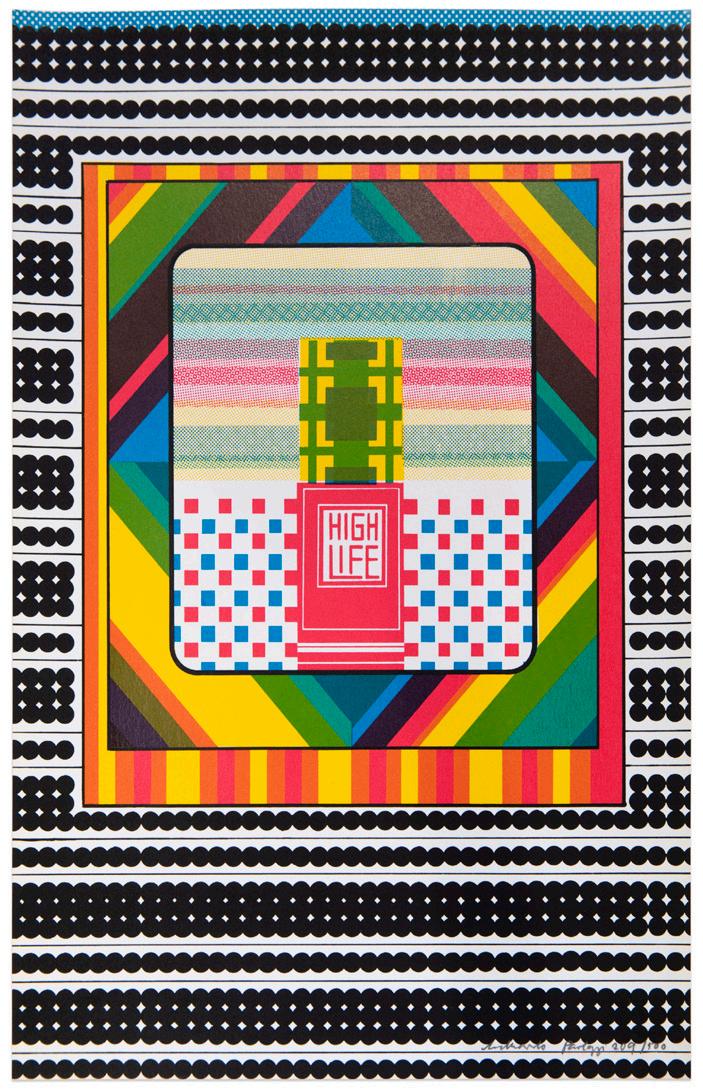
Robyn O’Neil
(born Omaha, Nebraska, 1977)
A Passing, 2004
Pencil on paper, 11 ¾ x 14 1/4 inches (framed)
Gift of Ann and Mel Schaffer, 2022.30.18
Robyn O’Neil makes intricate drawings and paintings of desolate landscapes, often containing human figures or animals. The attention to detail in the trees, and stark contrast of the white paper to represent a snowy landscape, give the drawing an elegant yet haunting or apocalyptic mood.
Eduardo Paolozzi
(born Edinburgh, Scotland,1924; died London, 2005)
High Life, 1967
From the portfolio Moonstrips Empire News Screen print, 16 1/2 × 11 1/2 inches (framed)
Gift of George Friedman and Diane Love, 1980.292.10
Eduardo Paolozzi was a sculptor, collage artist, and printmaker attracted to the precise mechanical exactitude of printmaking and its ability to create multiples. Paolozzi is known as a pioneer of the Pop Art movement with his abstract, brightly colored prints often influenced by advertisements.
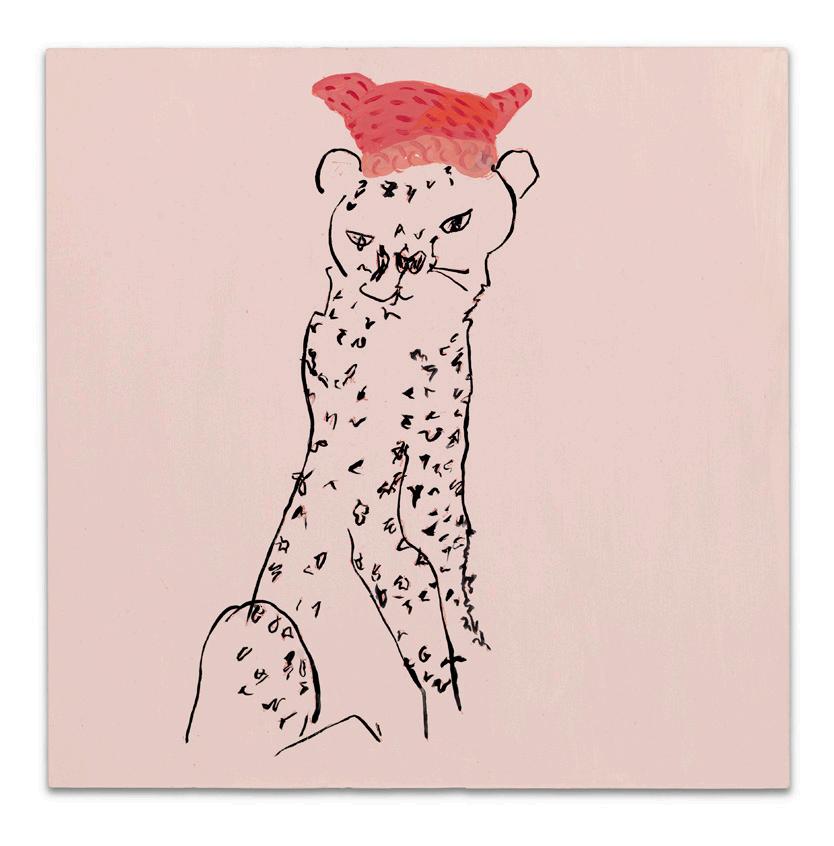

Roberta Paul (born Monticello, New York, 1956)
Pink Hat Cat #2, 2017
Colored pencil, gouache on wood panel 14 1/4 × 14 1/4 inches (framed)
Gift of Roberta Paul and bkprojects / beth kantrowitz, 2020.14
“The pink hats seen everywhere on January 20th, 2017 will remain with us forever. Worn by thousands of women marching across the world, the hats marked the emergence of a new movement. Pink Hat Cat is my personal response to the symbolism of the hat. The pink hat sits atop a cheetah, an animal that entered into my work as a recurring theme 8 years ago. The cheetah represents strength and dignity for me, and Everywoman.”
—Roberta Paul
Pablo Picasso
(born Andalusia, Spain, 1881; died Mougins, France, 1973)
Pour Roby, published 1978
Etching, 16 5⁄8 × 14 1⁄4 inches (framed)
Gift of Richard Levine, 2003.1.3.17
Pablo Picasso was a prolific artist who contributed to many different movements such as cubism, neoclassicism, and surrealism and mediums such as painting, drawing, and sculpture. After 1963, printmaking played an important role in Picasso’s process, and the quick execution of etching allowed Picasso to produce a large body of work in this medium. Here he uses a flowing line to portray the figure whose gaze meets the viewer.


Richard Prince (born Panama Canal Zone, 1949)
Fulton Ryder After Dark, 2012
Offset lithograph, 30 1/4 × 26 1/4 inches (framed) Gift of Jonathan Winter, 2020.7
Richard Prince is a painter, photographer, and sculptor. Recycling images from social media, advertisements, and entertainment, Prince challenges the boundaries of authorship and appropriation. In Fulton Ryder After Dark the title a reference to one of his pseudonyms—Prince displays an image from the cover of Agatha Christie’s The Mystery of the Blue Train next to his fictionalized pulpfiction book, which uses the same imagery.
Jesse F. Reed (born Belington, West Virginia, 1920; died Elkins, West Viginia, 2011)
Amazon Laundry, n.d.
Aquatint, 16 1⁄8 × 19 1⁄8 inches (framed)
Gift of Eva Marshall Bates Weaver, Class of 1921, 1988.13
Jesse F. Reed often depicted different cultures and their everyday narratives. There is a strong sense of peace despite the physical work being done, as a woman squats next to a body of water with her clothes. Thin lines define the figure, while loose marks make up her hair and the marsh surrounding the water.


Tyson
Reeder (born Fairfax, Virginia, 1974)
Ghost River, 2003
Mixed media on paper, 16 1/4 × 13 1/4 inches (framed)
Gift of Ann and Mel Schaffer, 2022.30.20
Tyson Reeder is a painter, draughtsman, and sculptor who investigates the power of play in the process of making his work. The materials he uses might include crayons, colored pencils, or paint, sometimes applied with his fingers. The subjects of his work are often landscapes, figures, and animals. Combined with his experimentation in tools and his cartoonish style he brings a childlike quality to the brightly colored work.
Kenny
Rivero (born New York, New York, 1981)
Walk Wit Me (The Band Has Arrived), 2021
Hand-embellished print on paper 23 1/2 × 23 1/4 inches (framed) Gift of Ann and Mel Schaffer, 2022.30.21
Kenny Rivero makes paintings, drawings, collages, and sculptures that investigate the complexity of his identity. Influenced by his Dominican American heritage and his religious upbringing in Catholicism and Vodun, themes of love, fear, and death are frequently conveyed symbolically. Often layering humor and unease, Rivero depicts a ghost and a hooded figure holding hands on a brick lined urban street. The figure’s exuberant gesture and the ghost’s diminutive size contrast with the moody background, leaving us uncertain whether to be scared or amused.
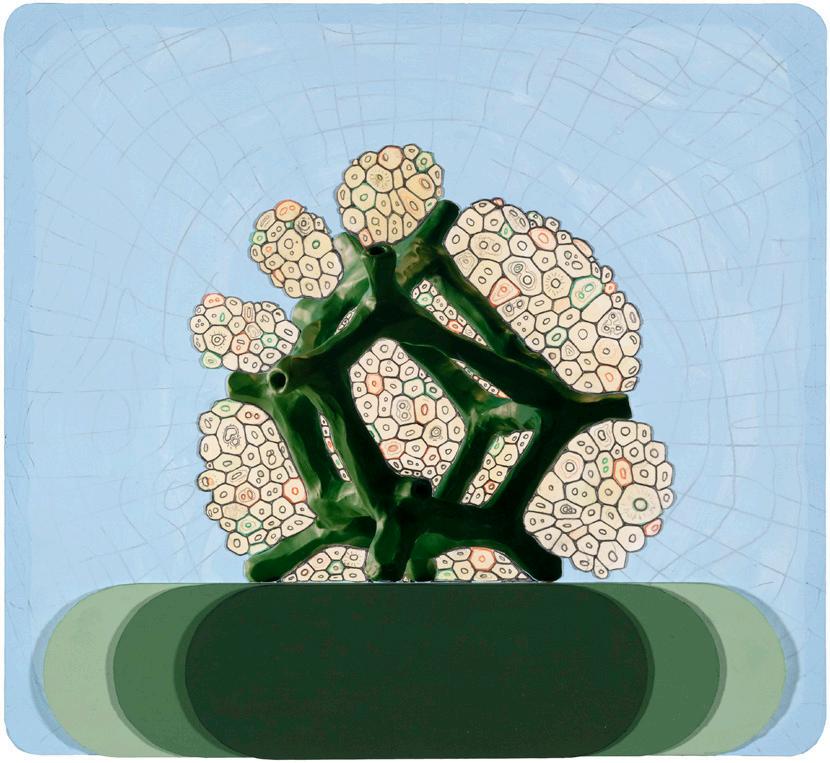
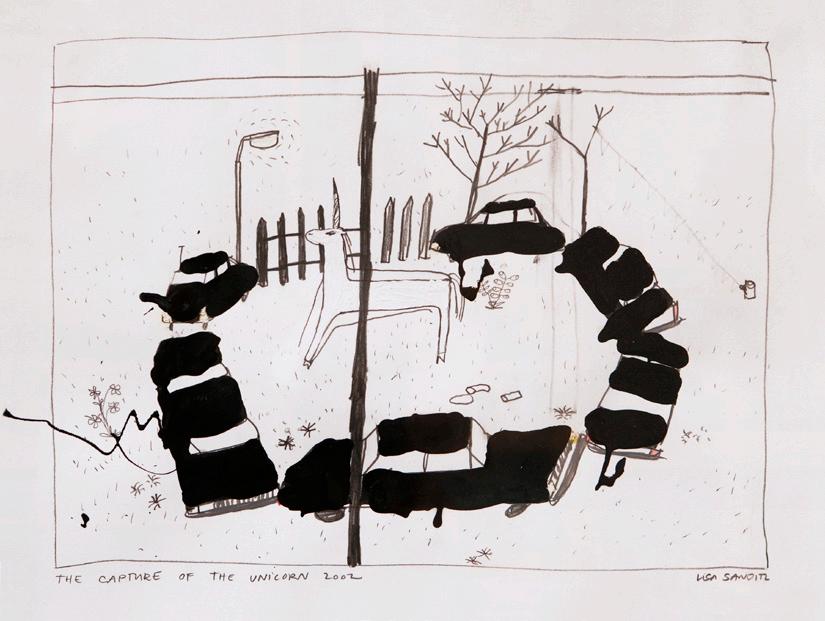
Alexander Ross (born Denver, Colorado, 1960)
Untitled, 2000
Ink graphite, colored pencil, flashe, color photo on paper 15 × 16 inches (framed)
Gift of Eileen and Michael Cohen, 2022.25.19
Alexander Ross makes paintings—and in this case collage—that are inspired by rocks, plants, and other organic forms. Although abstract, the blob-like forms have a familiar quality to them, as if we were looking at cells through a microscope. He begins by building small sculptures out of modelling clay which he then photographs and manipulates in photoshop. These images act as references from which he paints or makes collage, and his painting style accurately depicts highlights and shadows that suggest the molded dimensionality and smooth surface of the original form.
Lisa Sanditz (born St. Louis, Missouri, 1973)
The Capture of the Unicorn, 2002
Graphite and paint on paper, 14 x 17 inches (framed)
Gift of Judi Roaman, 2014.2.7
Lisa Sanditz intertwines contemporary culture and landscape in a humorous style. This drawing is a nod to the famous Unicorn Tapestries from the Middle Ages (1495–1505), one of which depicts a unicorn in captivity in a lush field. The original mystical landscape has been replaced with a dirty circle of cars, soda cans, and street lamps.
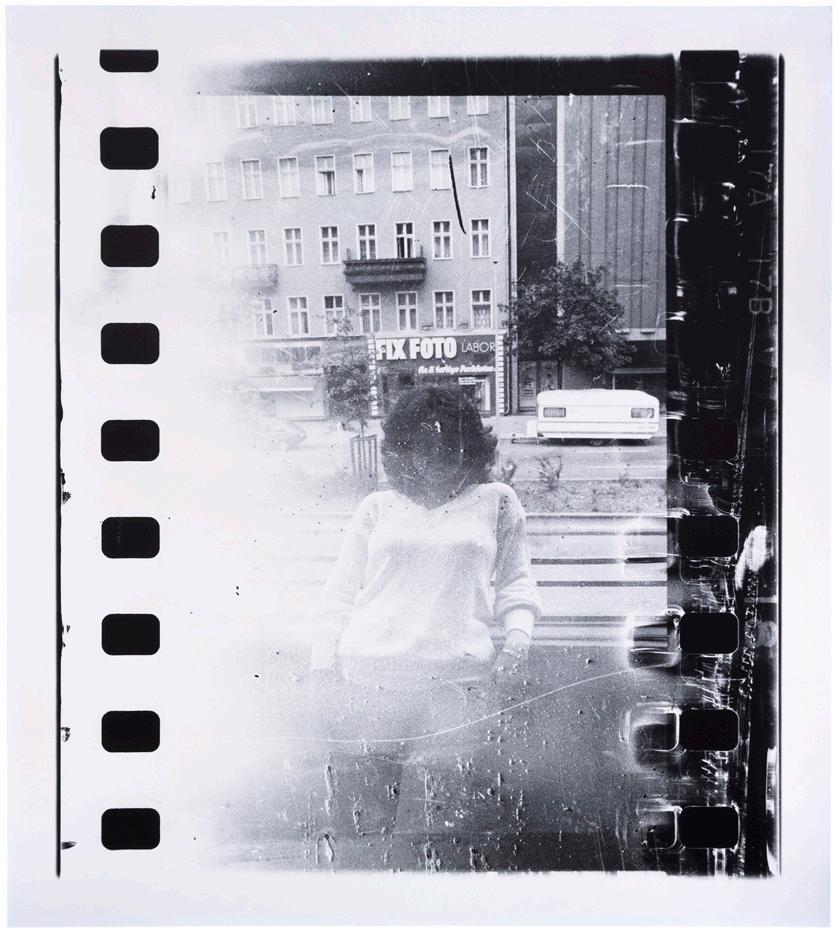

Joachim Schmid
(born Balingen, Germany, 1955)
Berlin, April 1986, from the series Arcana, 1996
Black-and-white pigment ink on paper 23 1⁄2 × 21 3⁄8 inches (framed)
Gift of the artist, 2018.35.1.9
In 1989, Joachim Schmid said, “No new photographs until the old ones have been used up!” Schmid collects the discarded negatives and photographs of others to make his work. This photograph, from his Arcana series, is a glimpse into the everyday life of strangers from different cities. Negatives are often torn, scratched, and destroyed before he finds them. By re-using discarded materials, Schmid gives the negatives and photographs a new life and beauty.
Carrie Schneider (born Chicago, Illinois, 1979)
Moon Drawing #244, 2015
Unique gelatin silver print from one negative 11 ¾ × 14 ¾ inches (framed)
Gift of Carrie Schneider, 2022.16
Carrie Schneider is a prolific photographer and filmmaker who uses chance and experimentation in the photographic darkroom to create her work. Moon Drawing #244 is one of the 300 images that she made over a full twenty-eight-day moon cycle in North Carolina’s Blue Ridge Mountains. Schneider used a medium format 6 × 7 camera and the same 30 rolls of film each night to capture the night sky and she rewound the film and shot multiple times in one night. The result is an image that is recognizable as a night sky but one with many moons, leaving the viewer to question and wonder about the nature of our own, and distant galaxies, and our understanding of them.
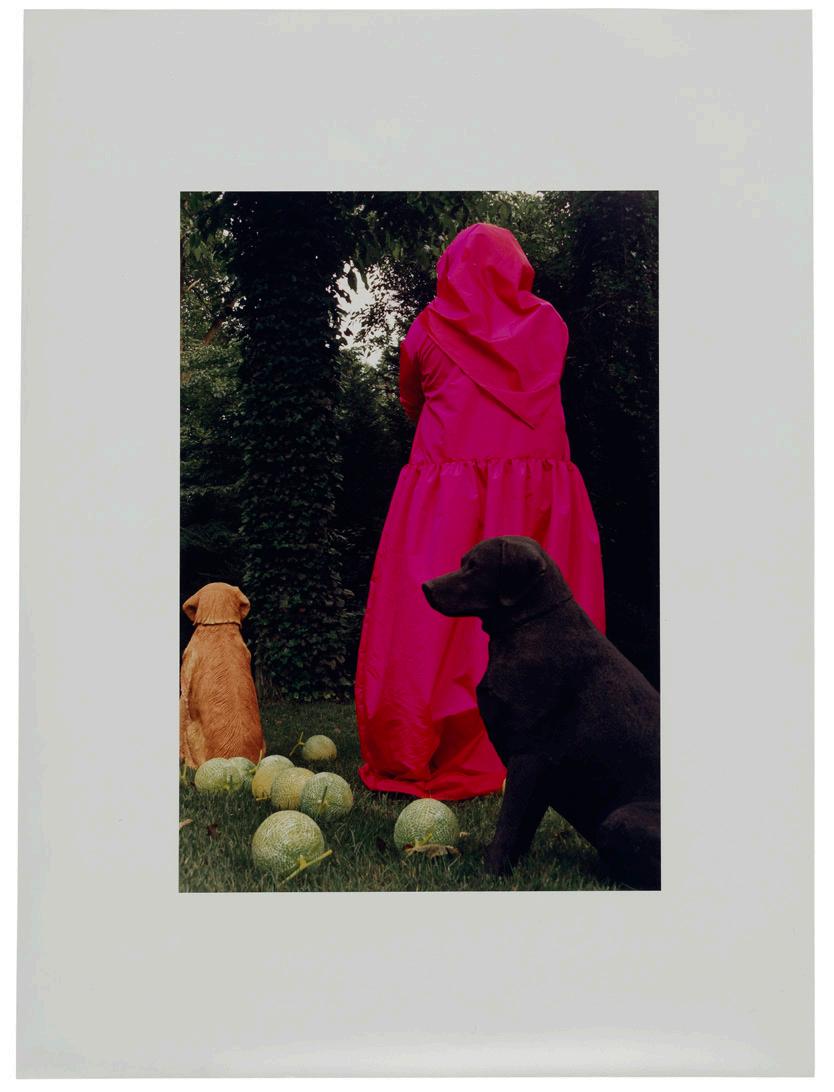

Beverly Semmes (born Washington, DC, 1958)
Untitled, 1999
Chromogenic print on paper, 21 × 16 1/4 inches (framed)
Gift of a private collection, 2019.15.1.6
Beverly Semmes makes sculptures, textiles, paintings, photographs, and performance art. Her work, which spans a variety of mediums, consistently examines the relationship between what is traditionally considered craft and fine art. Semmes combines mediums in this photograph, as if a still from a surreal performance in which a figure with their back toward us wears a red-hooded costume flanked by two dog statues.
Paul Mpagi Sepuya (born San Bernardino, California, 1982)
Studio (0X5A4983), 2020
Archival pigment print
15 1/2 × 12 1/4 inches (framed)
Gift of Ian Berry, 2020.10.1
Paul Mpagi Sepuya’s studio portraits feature the devices usually hidden behind the camera—backdrops, mirrors, tripods, and lights. He uses these props to fragment or obscure the nude Black male body, including his own. Sepuya’s Black queer gaze, subverting traditional portraiture, is often present in his photographs via a mirror reflection, where he can be seen looking at both subject and viewer through his camera.


Malick Sidibé
(born Soloba, French Sudan [now Mali], 1936; died Bamako, Mali, 2016)
untitled, 1980, printed 2004
Gelatin silver print, glass, paint, cardboard, tape, string 15 × 12 1/4 inches (framed)
Gift in memory of Claude Simard, 2017.36.7
Malick Sidibé was a prolific studio portrait photographer working in Bamako, Mali. Sidibé photographed the people of post-colonial West Africa, aiming to capture the music, fashion, and overall spirit of his community. The handpainted frame was made by Checkna Touré, who maintained a shop around the corner from Sidibé’s studio.
Hunt Slonem
(born Kittery, Maine, 1951)
Pillow Jungle, 1980
Screen print, 27 1⁄2 × 31 1⁄4 inches (framed)
Gift of Richard Liroff, 1985.76
Lavishly colored birds, plants, and lush patterns inhabit Hunt Slonem’s work. The artist’s fascination with the cultures and landscapes of far-off places started during his childhood traveling with his family to Nicaragua, Hawaii, and elsewere. Representational imagery and abstraction are combined to create a playful atmosphere.

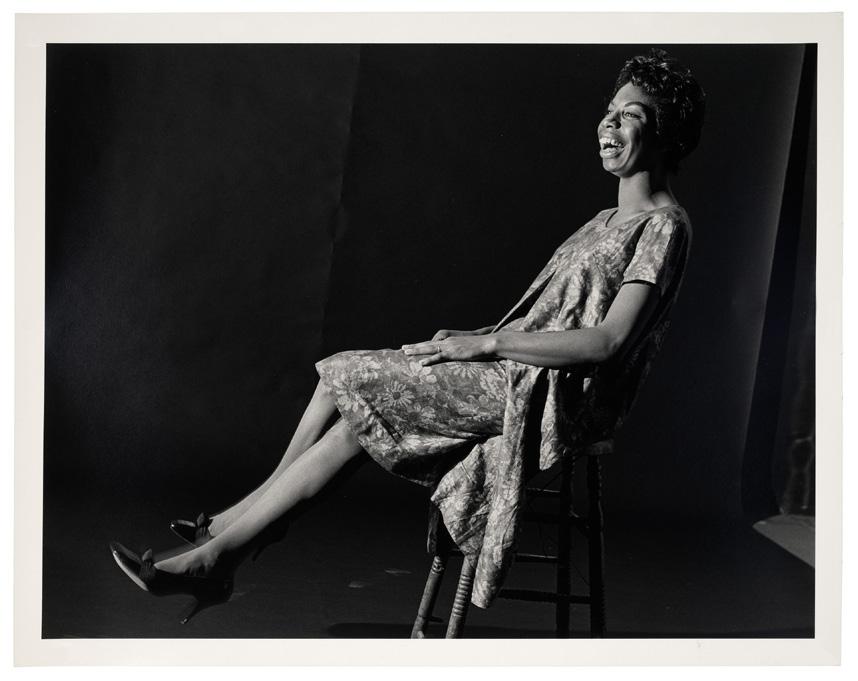
Shinique Smith (born Baltimore, Maryland, 1971)
Collage with Orange Flowers, 2007
Mixed media on paper, 13 × 10 7⁄8 inches (framed) Gift of Anne and Arthur Goldstein, 2015.3.27
Painter and sculptor Shinique Smith is known for her use of clothing, fabric, and calligraphy in her painting, sculpture, and collage work. Smith’s work interrogates questions around consumption and consumerism—what we buy, what we discard, and what those habits say about us.
Herb Snitzer (born Philadelphia, 1932; died St.Petersburg, Florida, 2022)
Happy Nina, 1959
Gelatin silver print on paper, 15 1⁄4 × 18 inches (framed) Gift of M. Robin Krasny in honor of Elizabeth Gronquist Sakman, 2018.30.32
Herb Snitzer worked as an editor and photographer for America’s leading jazz magazine of the mid-20th century, METRONOME, which allowed him to photograph many of the great jazz musicians of that era. Nina Simone, shown here laughing and reclining in a chair, was not only a singer- songwriter but also a civil rights activist.


Joan Snyder
(born Highland Park, New Jersey, 1940)
Another Version of Cherry Fall, 1996
Etching, chine collé, à la poupée woodcut on Mulberry paper, 28 1⁄4 × 26 1⁄8 inches (framed)
Gift of Mr. and Mrs. Gifford Phillips, 2008.4.6
Inspired by abstract expressionism, New York-born artist
Joan Snyder pushes the boundaries of abstraction by imbuing her paintings with a narrative quality. Known for experimenting with a wide range of media, colors, textures, and recurring motifs, Snyder’s Another Version of Cherry Fall expands upon an earlier work called Cherry Fall, allowing her to explore variations on a theme.
Georgina Starr (born Leeds, England, 1968)
Plan for Starrwood, 1999
Iris print on paper, 26 × 21 inches (framed)
Gift of a private collection, 2019.15.2.7
Georgina Starr primarily works in video, sound, and performance art, where she explores female identity and memory. In Plan for Starrwood, a faceless figure stands in a luscious tropical landscape by the water where flowers bloom and butterflies fly past. Starrwood is a play on the artists last name Starr, as if the place that is depicted is her personal utopia.

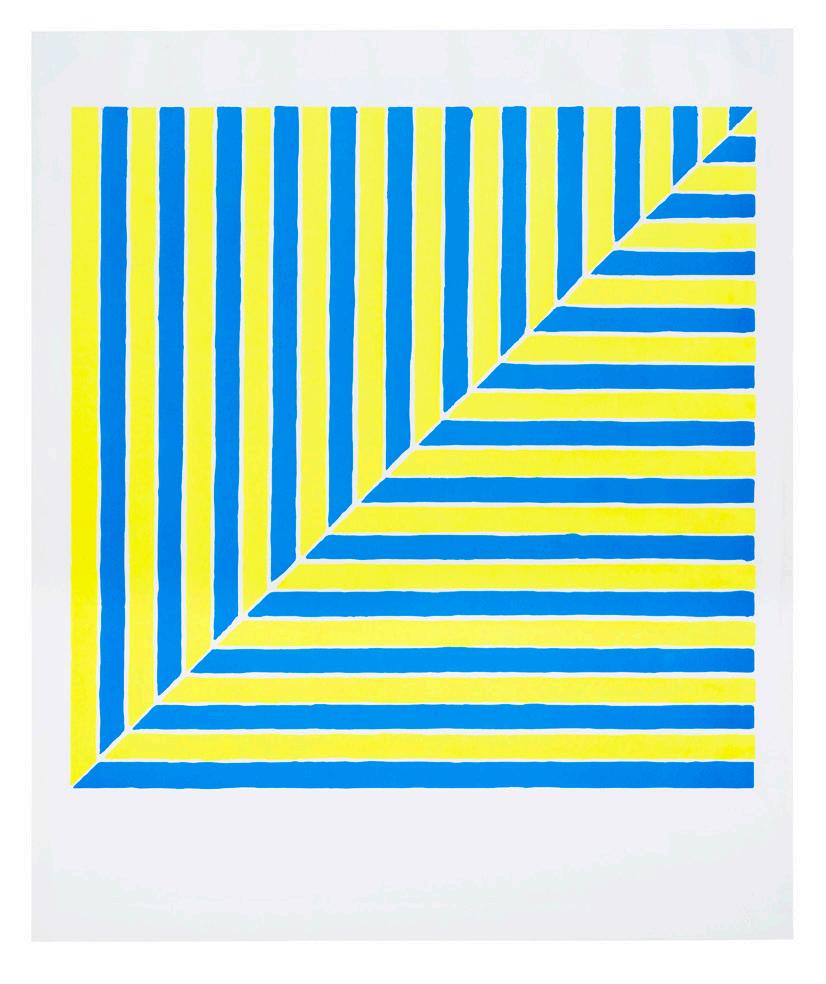
Terry Starr
(born British Columbia, Canada, 1951)
Soulcatcher, 1988
Screen print, 24 1⁄4 × 23 3⁄4 inches (framed)
Gift of Beverley Mastrianni, 2018.29.7
Terry Starr is from the Gispax Laats tribe, Eagle clan of the Tsimshian nation. The Tsimshian (pronounced “Shimshe-un”) are a Native American and First Nation people who live in the area of the International Boundary—at the southeastern-most tip of Alaska and then, going farther southeast and crossing into mainland coastal Canada. In addition to painting and printmaking, Starr is also a talented wood carver.
Frank Stella (born Malden, Massachusetts, 1936; died New York, New York, 2024)
Untitled (Rabat), 1964
Screen print, 21 5⁄8 × 24 1⁄4 inches (framed)
Gift of Anne T. Palamountain, 1966.4.3
Frank Stella was known for his contributions to abstract and minimalist art. Stella is best known for geometric shapes and patterns in his painting, sculpture, and printmaking. He believed that painting should not try to imitate reality, and famously stated, “what you see is what you see.”

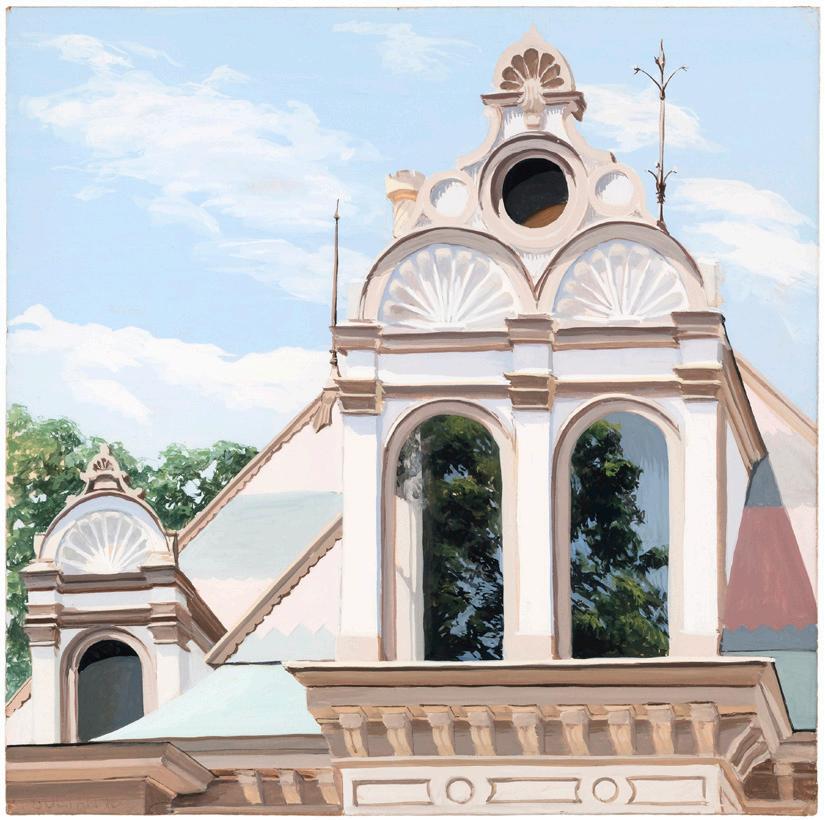
Joseph
Stella
(born Muro Lucano, Italy, 1877; died New York, New York 1946)
Tree, 1978
Intaglio, 13 3⁄4 × 12 inches (framed) Gift of Richard Levine, 2003.1.3.23
This print of a tree was made using an intaglio printmaking process in which the image is created on a metal plate, then transferred to paper by inking it and running it through a press with a sheet of paper. Stella was often frustrated by the industrial landscape in which he was living, but also in awe of its advancement. Here Stella chooses to focus on the beauty and complexity of nature.
Altoon Sultan
(born Brooklyn, New York, 1948)
Vic torian Mansion, Saratoga Springs, NY, 1976
Gouache on board, 12 1/4 × 12 1/4 inches (framed) Promised Gift of Jack Shear, EL2020.9.11
Altoon Sultan is known for her landscapes and architectural paintings that reveal her attention to light, spatial relationships, and color. At first glance, this small painting could be mistaken for a photograph, as it realistically highlights the intricate architecture of a Saratoga Springs Victorian home and the reflection of a tree in the windows.
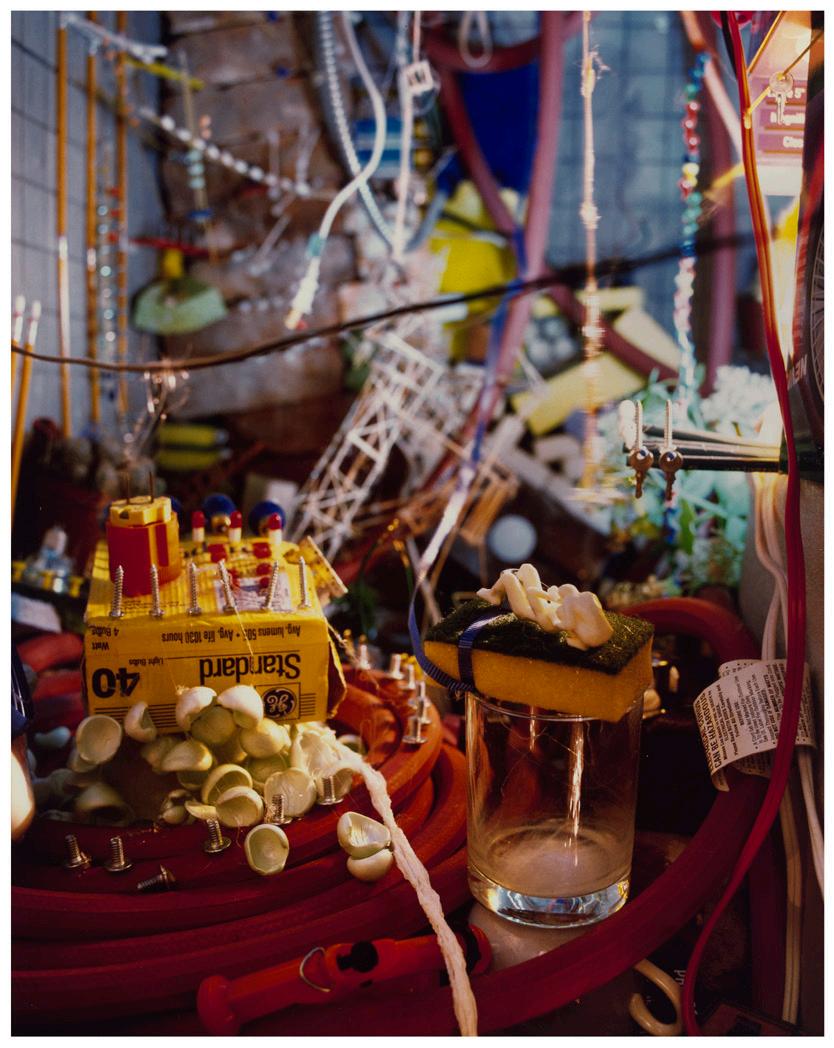

Sarah Sze (born Boston, Massachusetts, 1969)
P.242, 1998
Cibachrome print on paper, 24 1/2 × 20 1/2 inches (framed) Gift of a private collection, 2019.15.2.2
Sarah Sze makes installations that combine mundane everyday objects such as extension cords, screws, and kitchen sponges to create intricate sculptures. These large-scale installations react to the interior architecture that spans the majority of the space in which they exist. This photograph is a close-up of an installation by Sze, which captures the whimsy and dynamic quality of her work, where objects feel as though they could take on a life of their own.
Adrienne Elise Tarver (born New Jersey, 1985)
World, 2021
Archival pigment print on paper, 16 × 13 1/2 inches (framed) Tang purchase, 2021.23
Adrienne Elise Tarver is an interdisciplinary artist whose work addresses Black female identity and invisibility. World is a “card” from her project Manifesting Paradise, which is inspired by tarot cards and their framework of symbols that represent potential future outcomes. This project was born out of the Black Lives Matter protests of 2020 and the COVID pandemic, with hopes for a better future.
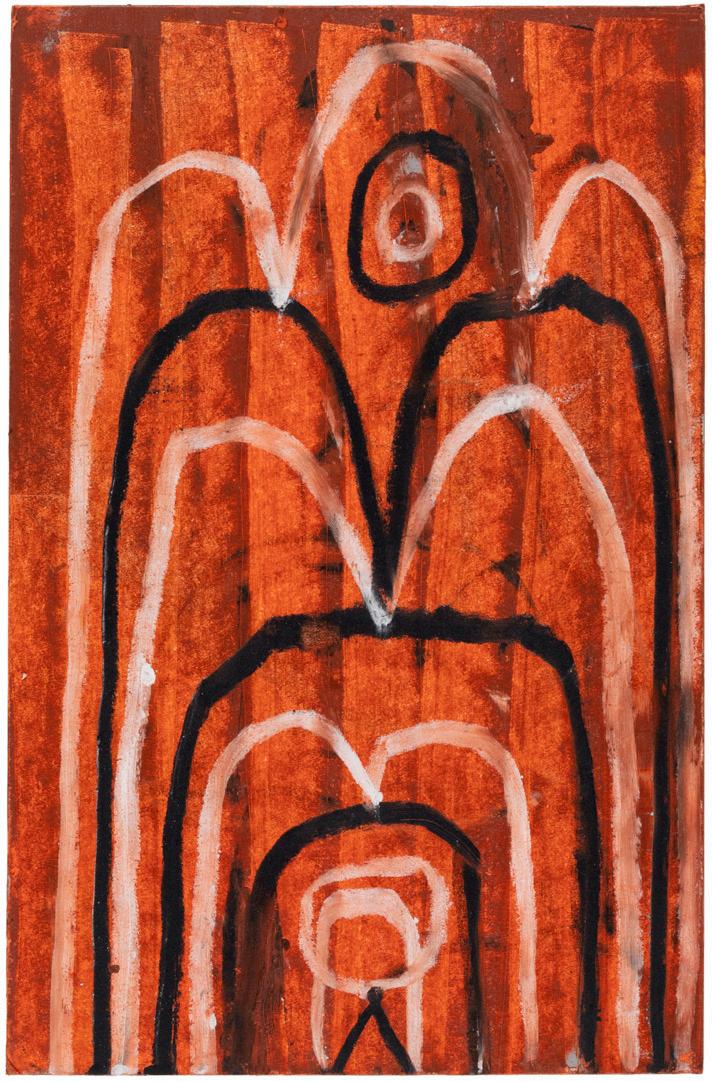
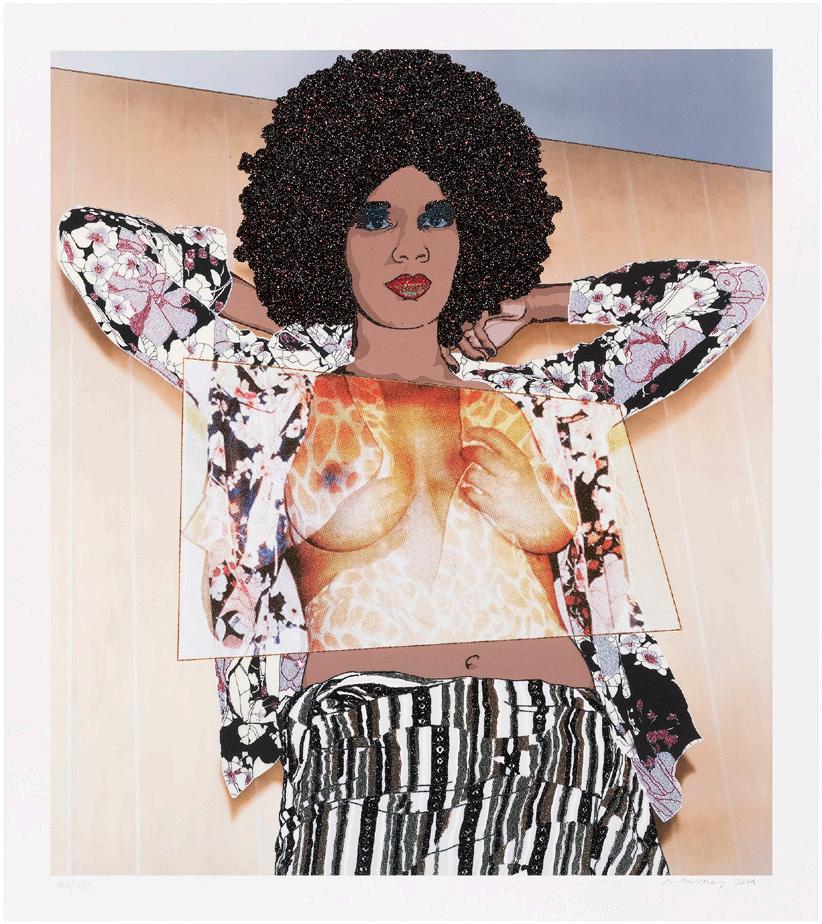
Whiting
Tennis
(born Hampton, Virginia, 1959)
Untitled, 2023
Acrylic on paperboard, 14 3⁄8 × 11 3⁄8 inches (framed)
Gift of Ian Berry, 2023.13
Whiting Tennis is a contemporary artist known for painting, drawing, sculpture, and collage that explore various styles. His expressive abstract works are sometimes the result of Surrealist automatism, a process popularized in the 1920s that relinquishes the conscious mind’s decision-making skills and releases the unconscious onto the drawing surface.
Mickalene
Thomas
(born Camden, New Jersey, 1971)
Portrait of Maya #10, 2024
UV pigment print with 4 metallic silkscreen and shimmer layers, a CMYK silkscreen central panel and matte varnish layer on Somerset Tub Sized Radiant White 410gsm paper
24 5⁄8 × 22 1⁄8 inches (framed)
Tang purchase, 2024.19
Known for applying rhinestones, acrylic, and enamel to her portraits, African American artist Mickalene Thomas uses bling and flashiness to bring light to topics such as sexuality, gender, and race within her work. Here, Thomas’s portrait of her former lover in their shared Brooklyn apartment emphasizes her subject’s chest with a color shift and framing device layered over her torso.
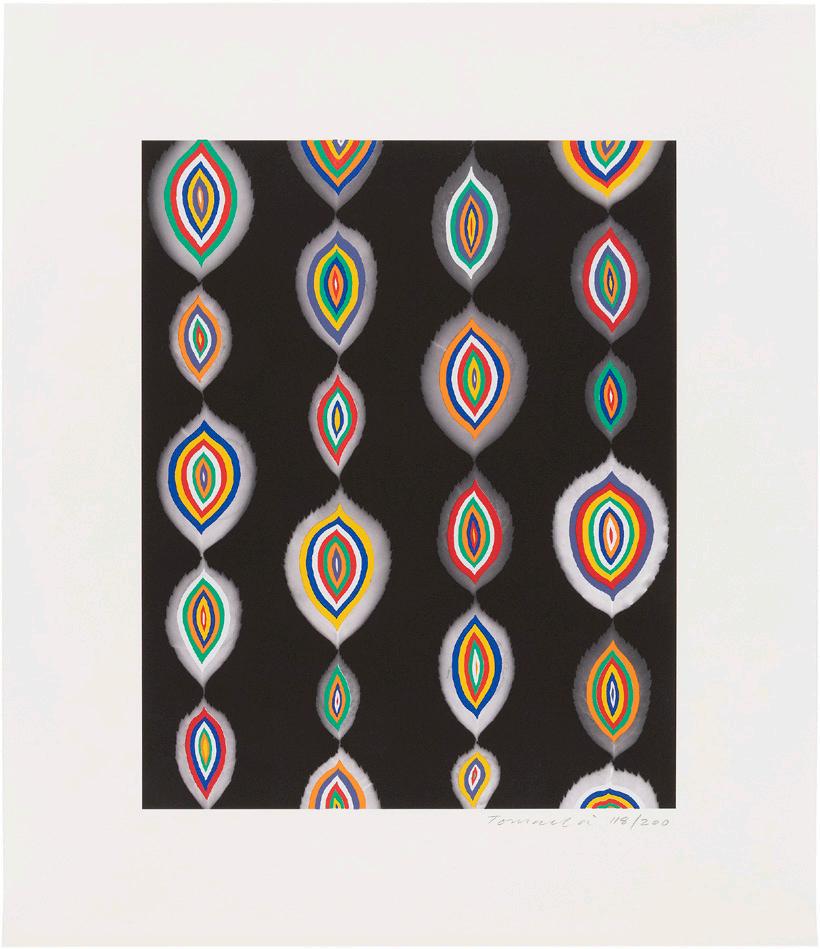

Fred Tomaselli
(born Santa Monica, California, 1956)
Bloom, 2011
Screenprint over archival inkjet print
15 1⁄2 × 13 1⁄2 inches (framed)
Gift of Jan and Robert Andersen, 2024.24.2
Fred Tomaselli’s works explode in mesmerizing bursts of color that depict abstract patterns and natural forms in a range of unusual materials. Tomaselli often uses a hybrid of collage and painting, incorporating materials such as medicinal herbs, prescription drugs, hallucinogenic plants, and cuttings from printed material. This print exemplifies his love of psychedelic colors and repeating patterns which hover between ornamentation, representation, and hallucinatory vision.
Carl Van Vechten
(born Cedar Rapids, Iowa, 1880; died New York, New York, 1964)
Alicia Markova as “The Dying Swan,” 1948
Gelatin silver print, 10 1/4 × 8 1/4 inches (framed)
The Jack Shear Collection of Photography at the Tang Teaching Museum, 2017.41.686
Carl Van Vechten was a writer and photographer who photographed over 9,000 portraits. Working in black and white film photography, and then eventually color, he was revered for his talent in portraiture, which captured the accomplished individuals of his time. Many of the portraits are of his friends, artists, writers, dancers, musicians, athletes and politicians. Photographed here is Alicia Markova a British ballerina, choregrapher, director and teacher of classical ballet.
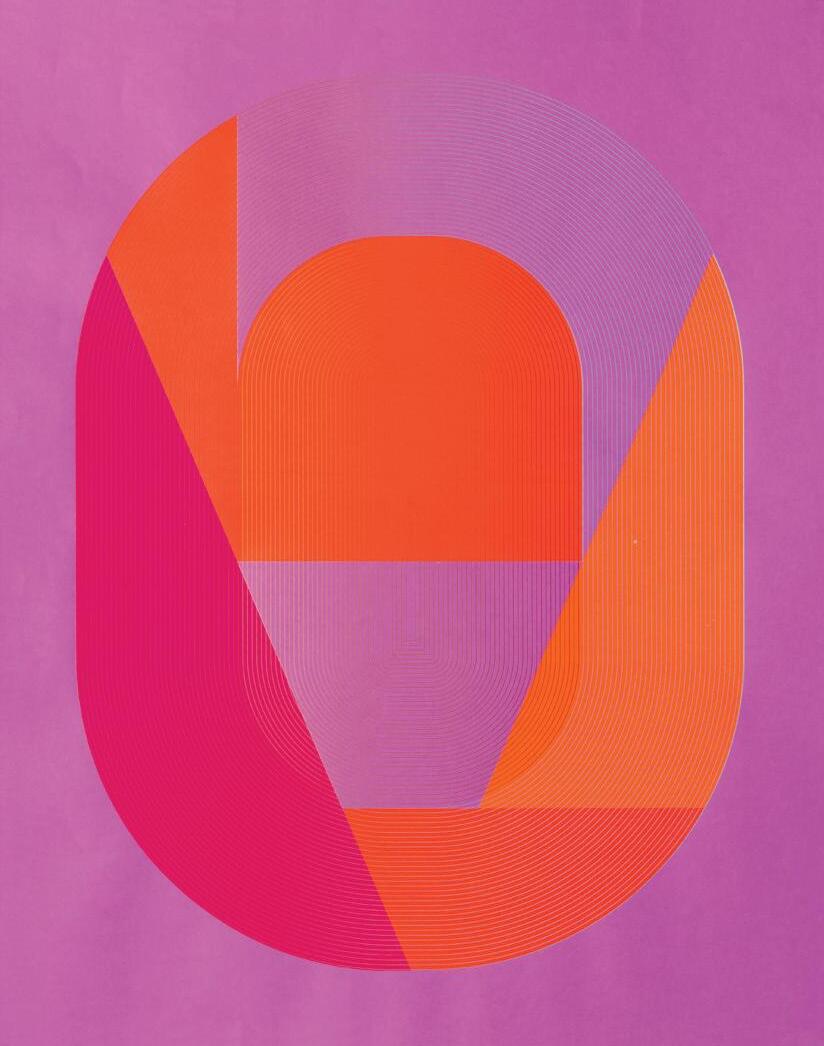

Kimberly Varella (born California, 1970)
Encino Velodrome from The Machine Project
Field Guide to L.A. Architecture, 2013
Screen print, 29 1/2 × 23 ¾ inches (framed)
Gift of Mark Allen, 2018.6.47
Kimberly Varella is a Los Angeles–based designer who blurs the lines between art and design. In 2013, Machine Project invited thirty artists, including Varella, to create designs that responded to notable architectural sites around the city of Los Angeles. The oval-like form in this poster is based on an aerial view of the Encino Velodrome, a racetrack in Encino, California. With a palette of oranges and purples, the rhythmic repetition of line is reminiscent of riding the track at sunset. Varella also designed the Tang’s 2016 exhibition catalog Machine Project: The Platinum Collection, which explores unconventional ways of seeing and thinking about the world.
Paloma Varga Weisz (born Mannheim, Germany, 1966)
Dreiaugenfrau (Three-Eyed Woman), 1999–2000
Colored pencil on paper, 16 1/4 × 13 1/4 inches (framed)
Gift of Jay Gorney and Tom Heman, 2021.28.18
Paloma Varga Weisz makes surreal drawings, paintings, and sculptures. Her figures sometimes turn into animals or are drawn with beautiful but grotesque features, such as in this drawing. The surreal or supernatural quality of her subjects suggests a mythic or folkloric narrative.

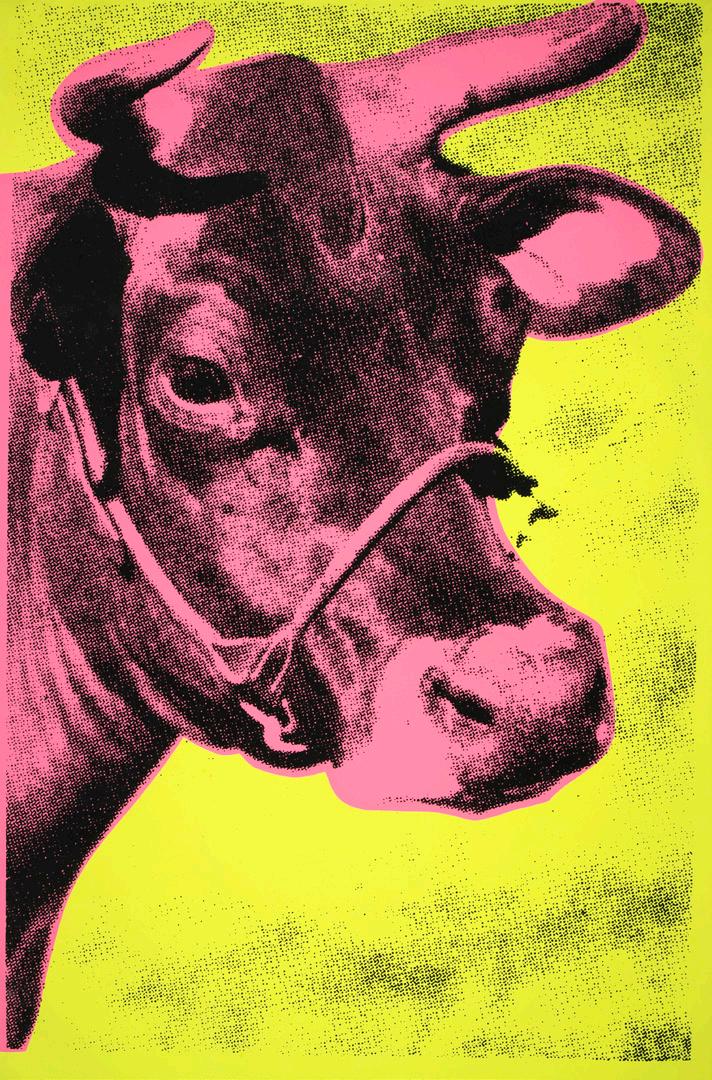
Victor Vasarely
(born Pecs, Hungary, 1908; died Paris, 1997)
Pengo-Z, 1975
Screen print, 26 5⁄8 × 24 3⁄4 inches (framed)
Gift of Leon N. Nad, 1984.489
Influenced by Bauhaus principles and Constructivism, as well as artists like Wassily Kandinsky, Victor Vasarely—a leader of the Op art movement—creates optical illusions through play with geometric shapes and color.
Andy Warhol
(born Pittsburgh, Pennsylvania, 1928; died New York, New York, 1987)
Cow, 1966
Screen print on wallpaper, 51 × 31 1/4 inches (framed)
Gift of Jack Shear, 2018.36.72.2
Andy Warhol is known for his contribution to the Pop Art movement, which borrowed from popular culture and challenged fine-art traditions. Warhol worked in various mediums, such as photography, printmaking, and installation. Cow is a portion of a much longer vertical strip of wallpaper that Warhol screen printed in his studio. When installed on the walls of a gallery, the repetitive imagery of the magenta cow would surround visitors, bringing to light ideas of mass production and consumerism.

Chuck Webster (born Binghamton, New York, 1970)
Skidmore Set #3, 2019
Mixed media on antique paper 13 ¾ × 11 ¾ inches (framed)
Gift of the artist, 2021.24.3
Known for his drawings, prints, collages, and paintings, contemporary artist Chuck Webster invites viewers into worlds of abstraction. Strange yet familiar, his works speak to somewhere deep in the viewer’s subconscious, teasing the mind with forms that seem to be derived from architecture, plants, or people, yet remain abstract and elusive.

William Wegman (born Holyoke, Massachusetts, 1943)
Piers, 1993
Chromogenic print, 16 5⁄8 × 14 3⁄8 inches (framed)
Gift of Betsy Senior, 2023.20.1
The solemn faces of these Weimaraner dogs lend themselves to the playful whimsy that defines the photography of William Wegman. Although he began his artistic career in the 1960s as a conceptual artist and then as a painter, Wegman is most well-known for photographs of his beloved dogs, intentionally posed and sometimes wearing human clothing and wigs. In these portraits, conceptual concerns, formal composition, and the canine’s dispassionate stare meld to create a sense of curiosity and absurdity.

John Wesley
(born Los Angeles, 1928; died New York, New York, 2022)
Red Lips, 2005
Six-color screen print in water based inks
29 × 23 1/2 inches (framed)
Gift of Ann and Mel Schaffer, 2023.30.22
John Wesley famously rejected all stylistic classification concerning his work and was mysterious about his artistic process. Despite this, his work has clear connections to Pop Art, in his use of a cartoon or comic strip aesthetic, with bright blocks of color. Wesley uses this familiar visual language to depict ambiguous scenarios of human emotion, such as fear, desire, guilt, joy, and despair.

T.J. Wilcox
(born Seattle, Washington, 1965)
Fraise des bois, 2003
Color photograph, 24 1/2 × 17 inches (framed)
Gift of Jay Gorney and Tom Heman, 2021.28.23
T.J. Wilcox took this photograph from his silent film Strawberry, where the small wooden figures guard the artist’s plant and celebrate the growth of a strawberry. Wilcox embraces a homemade aesthetic and produces his work without the help of a professional film crew. He also uses found footage and animations in his films. Wilcox is interested in sharing personal narratives that allow the viewer’s imagination to run wild.

Deborah Zlotsky
(born Los Angeles, California, 1962)
Gringe, 2006
Powdered graphite on mylar, 16 1⁄8 × 14 inches (framed) Gift of the artist, 2023.2
This abstract drawing by Deborah Zlotsky uses mylar rather than paper and a range of tools such as powdered graphite, erasers, sponges and even canned air. Her process begins with an initial mark that sparks her imagination and allows her to two-dimensionally sculpt the form with erasers and layering. This work contains forms that feel reminiscent of the human body, like organs or teeth. The abstract forms morph into twisting, swelling animal/ human hybrids.

When I went abroad my junior year to Florence, Italy, I visited the Uffizi Gallery, where Caravaggio’s Medusa was on view. Upon seeing Medusa, I immediately thought of Vik Muniz’s Medusa Marinara in the ROOM•MATE collection, which brought me a sense of comfort and familiarity while 4,000 miles away from the Tang. When I left the gallery, I knew exactly which ROOM•MATE artwork I was going to go home with in the fall.
It was so memorable to be able to see the sixteenth-century painting of a Greek mythological figure and to later display a parody of that historical artwork in my own home. I really enjoyed how the mini “gallery” containing Medusa Marinara and the postcard of Medusa that I set up in my house demonstrate how appropriation and reinterpretation contribute to the evolution of visual culture.
—Sasha
